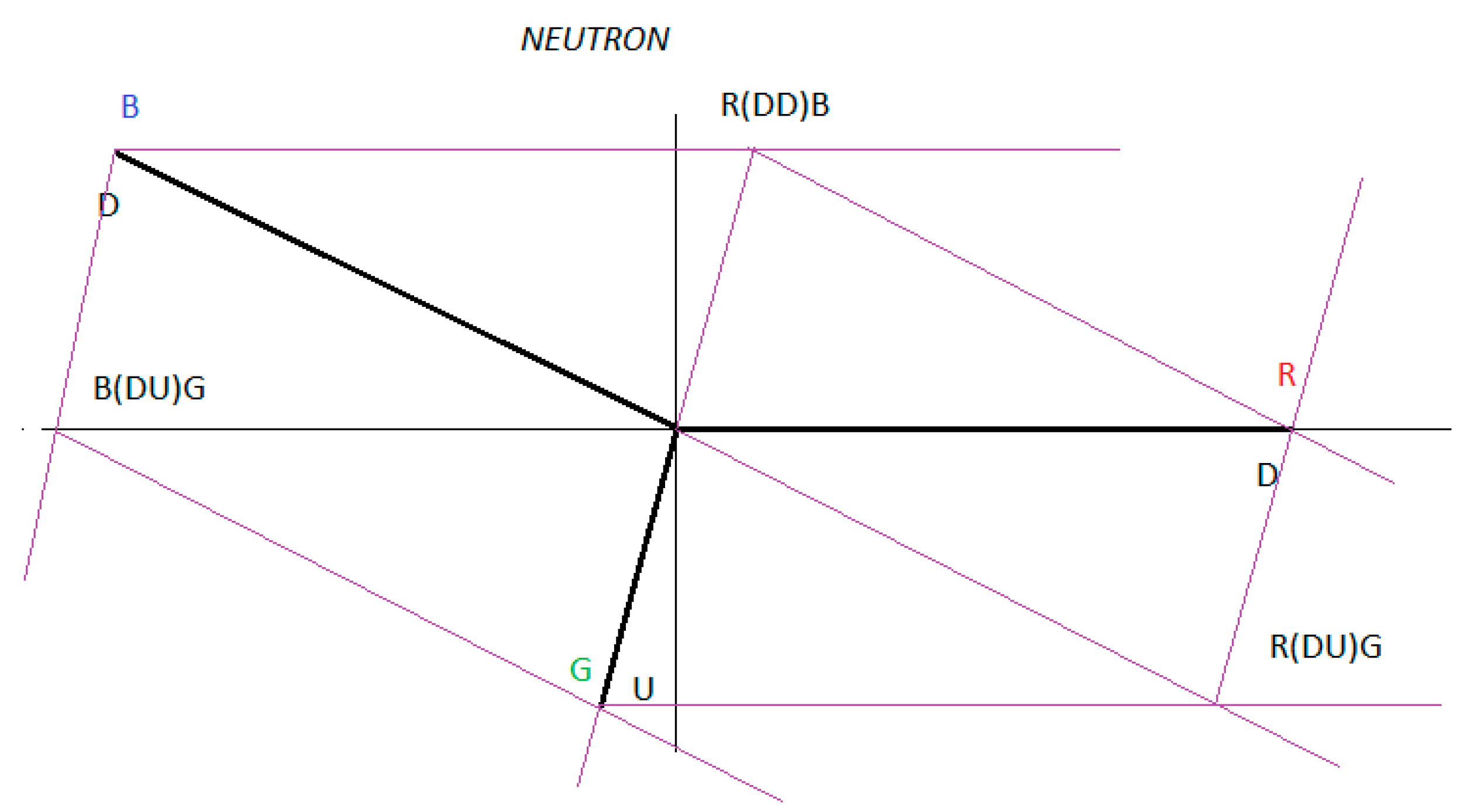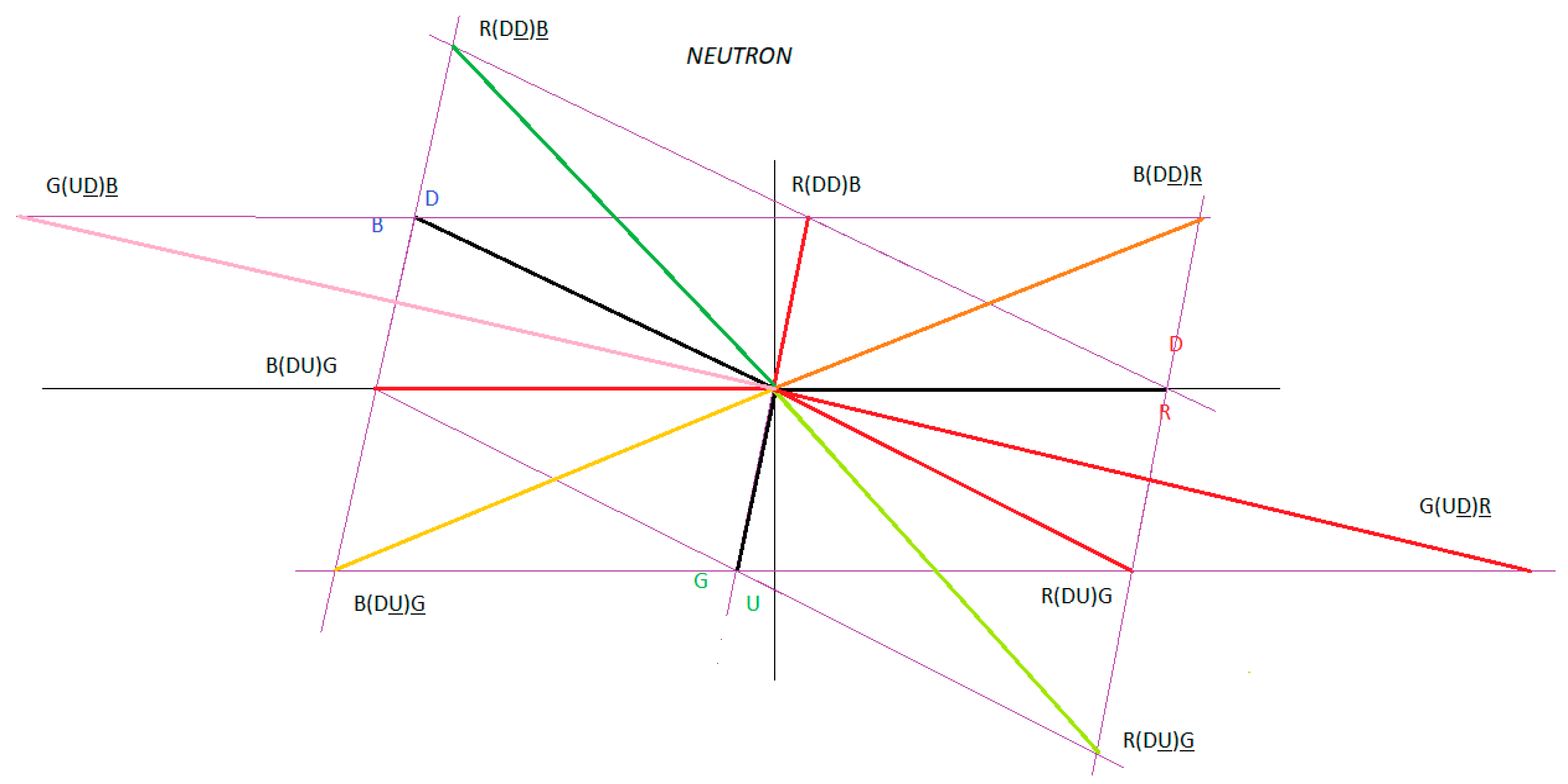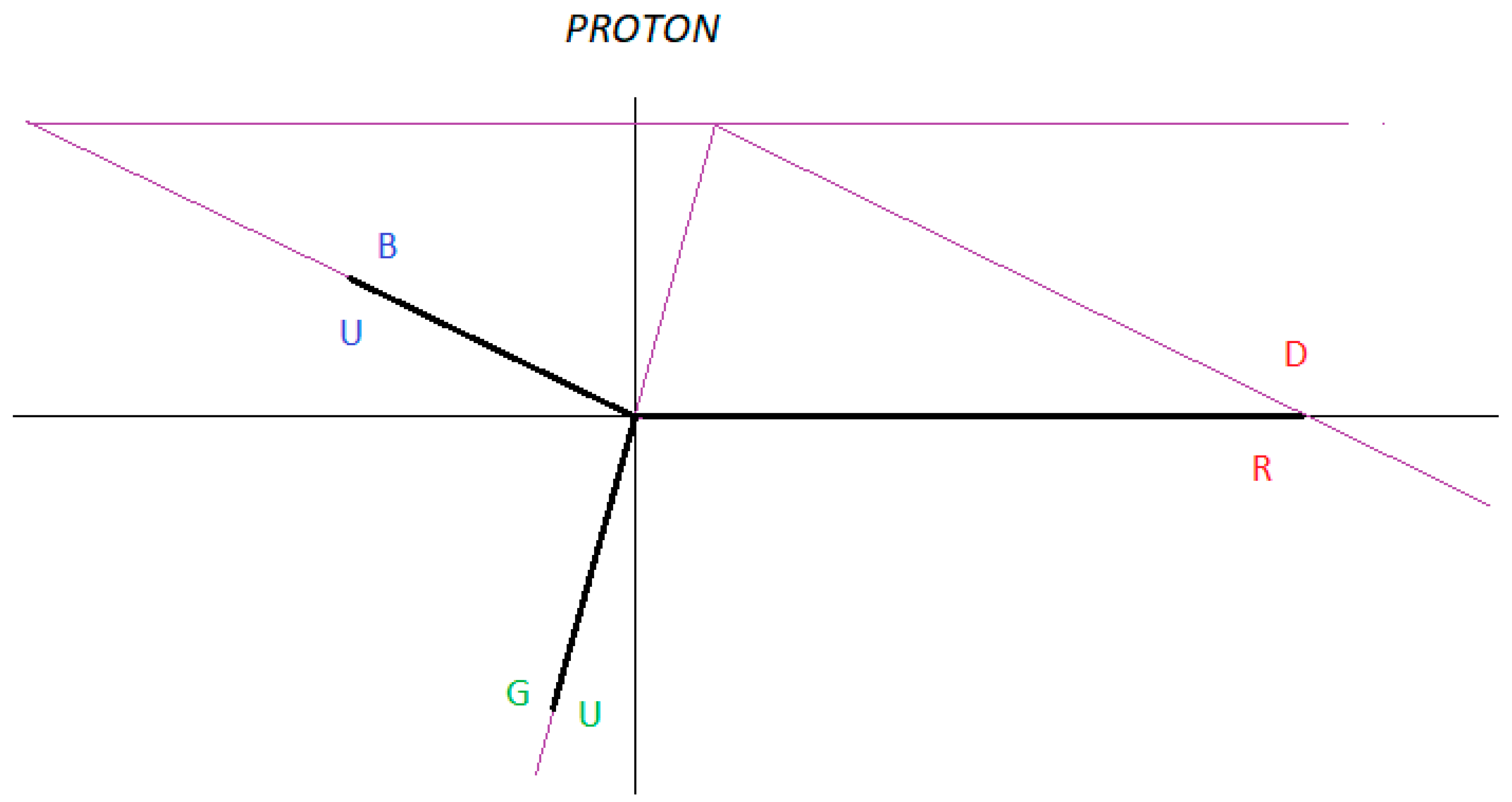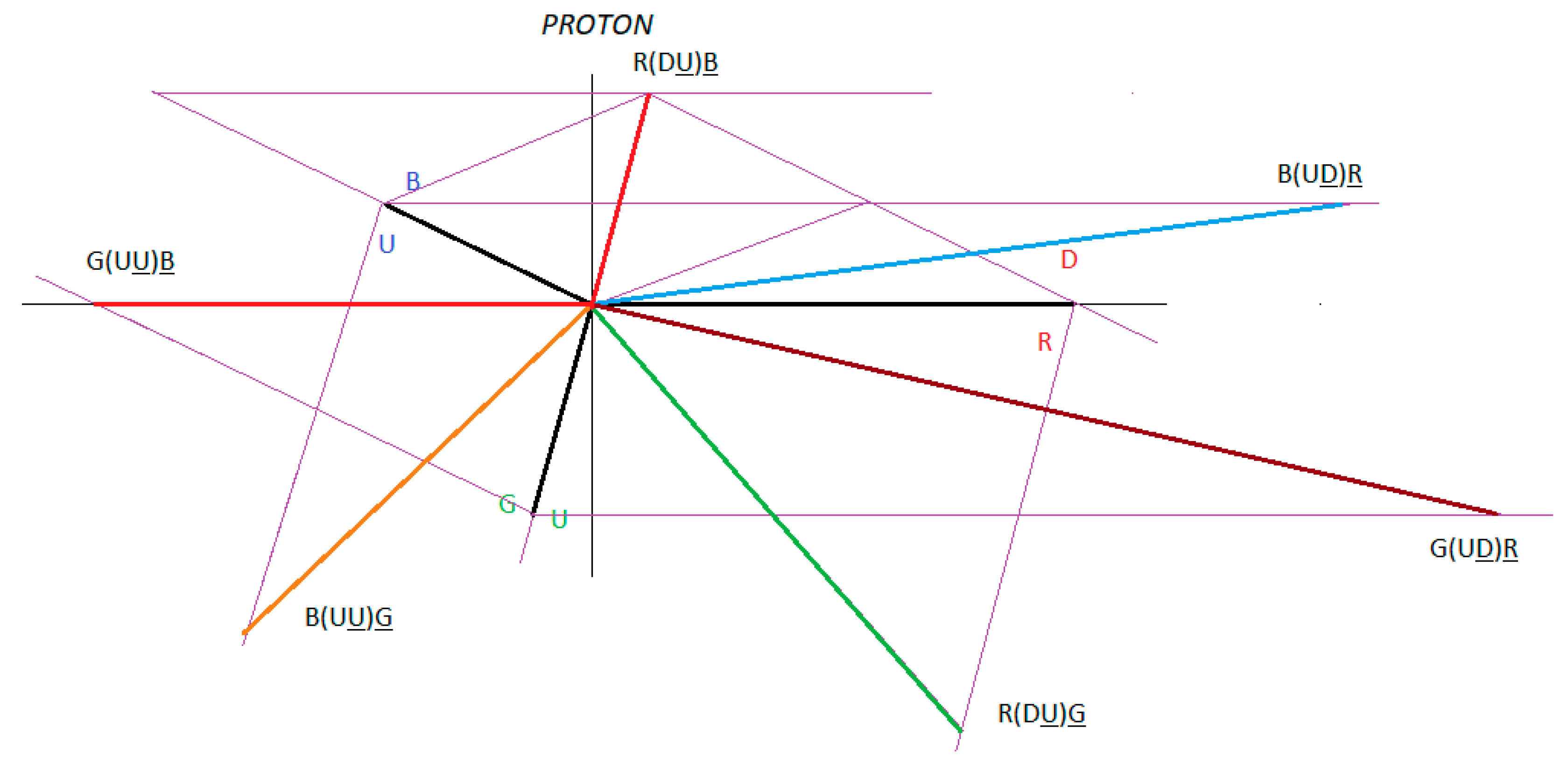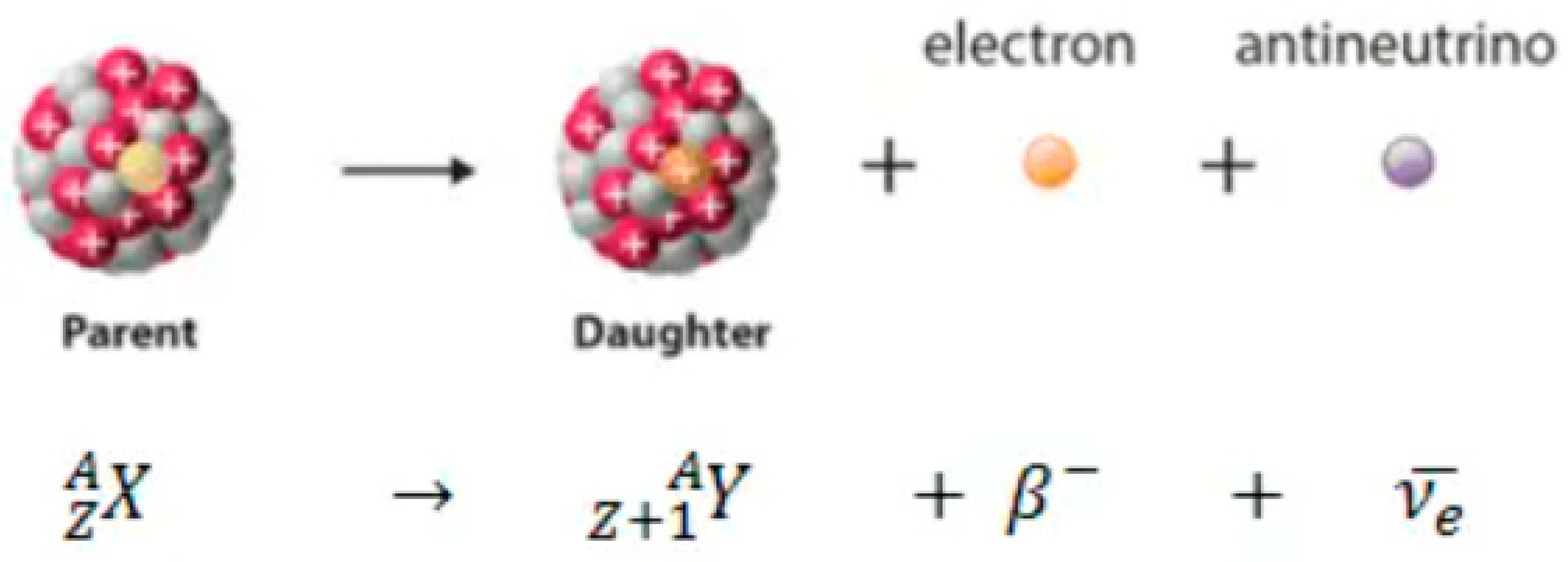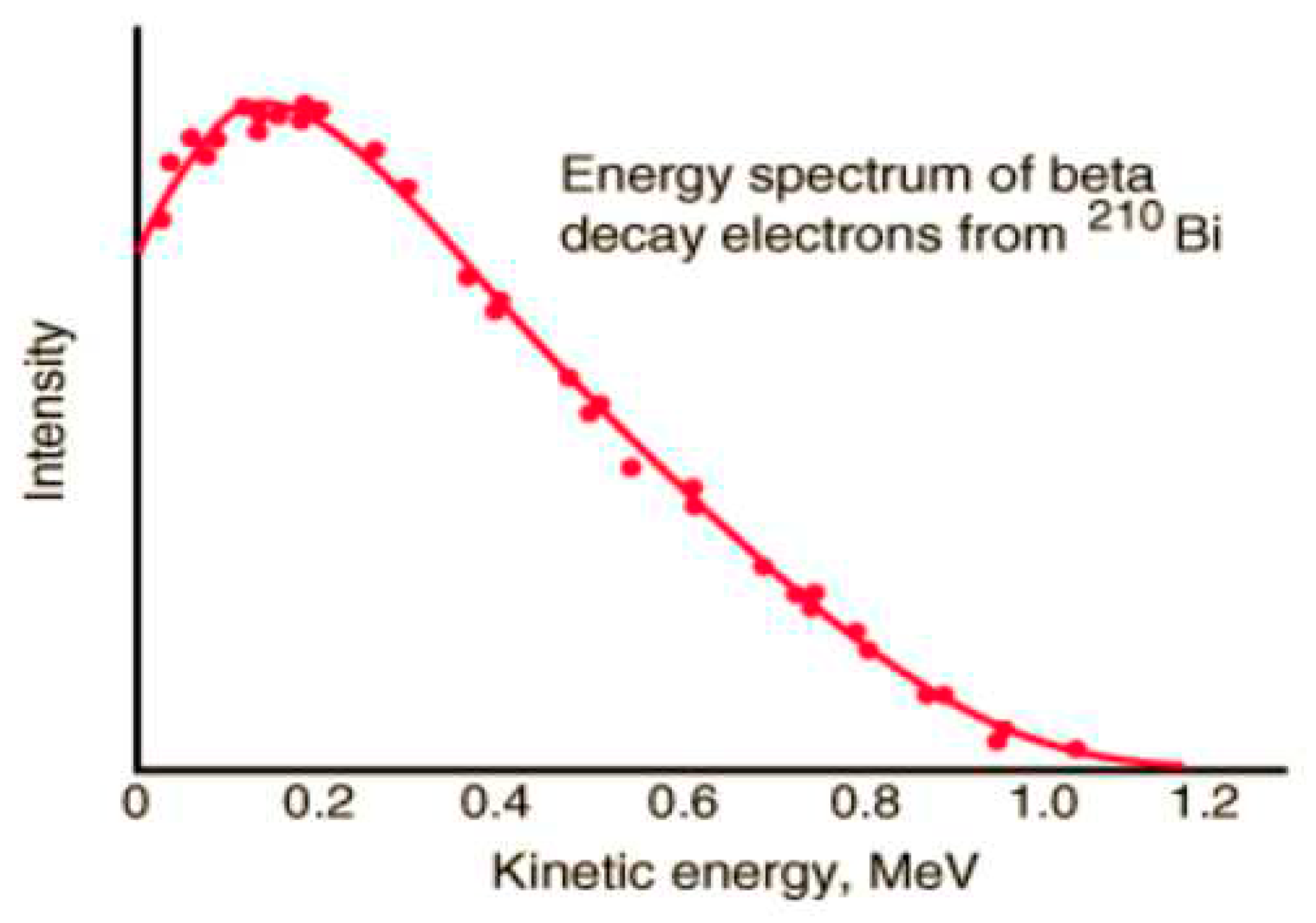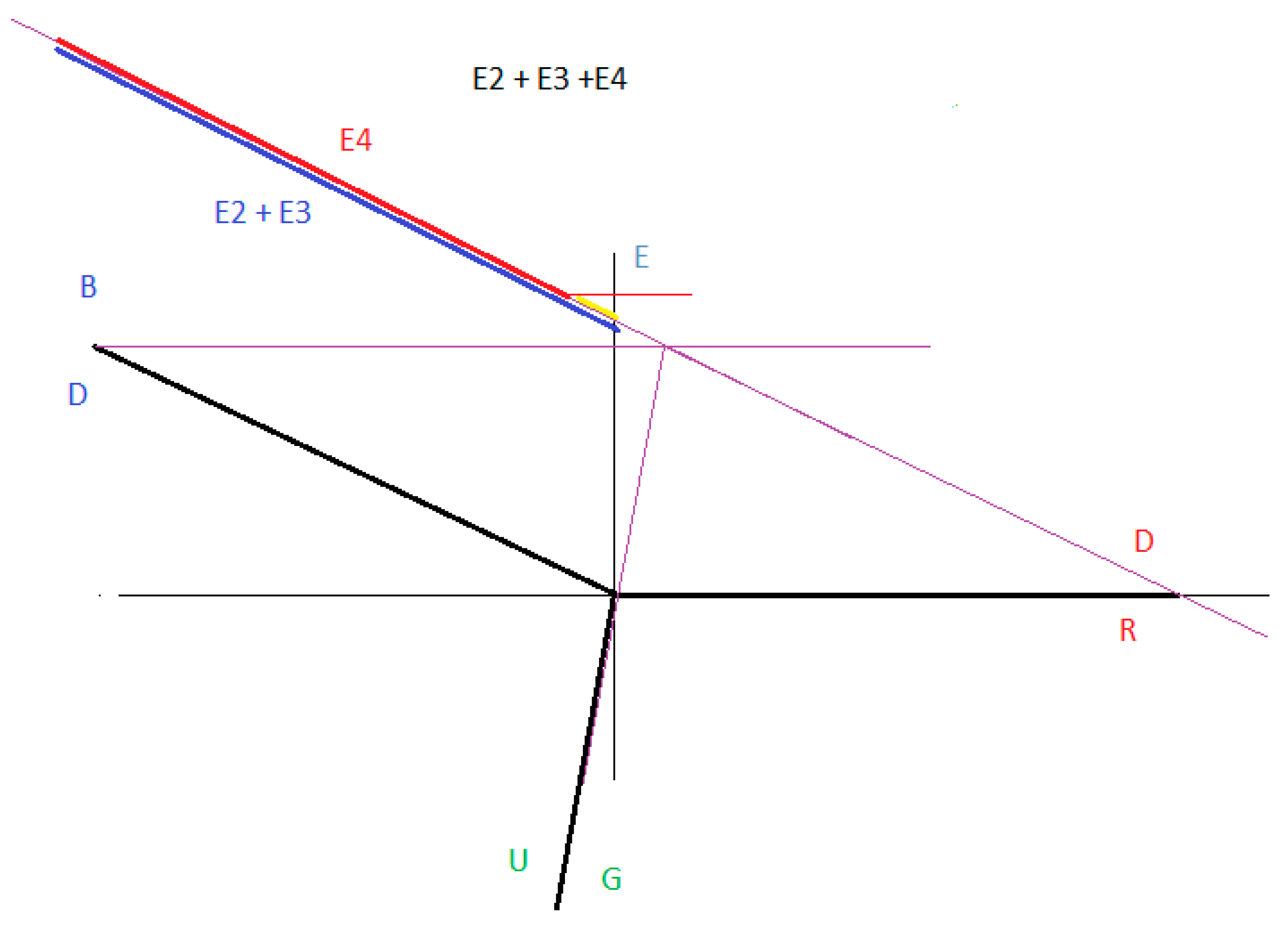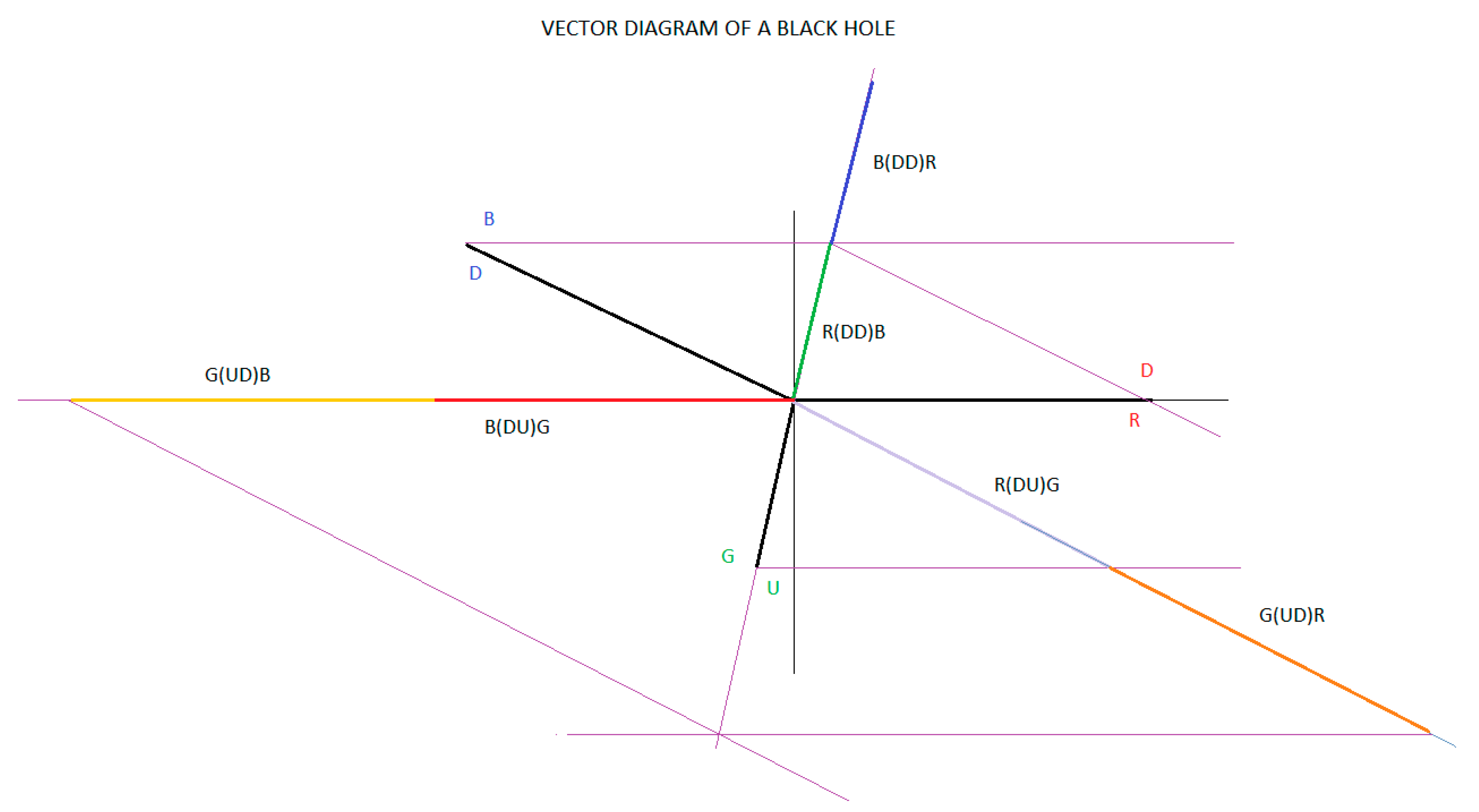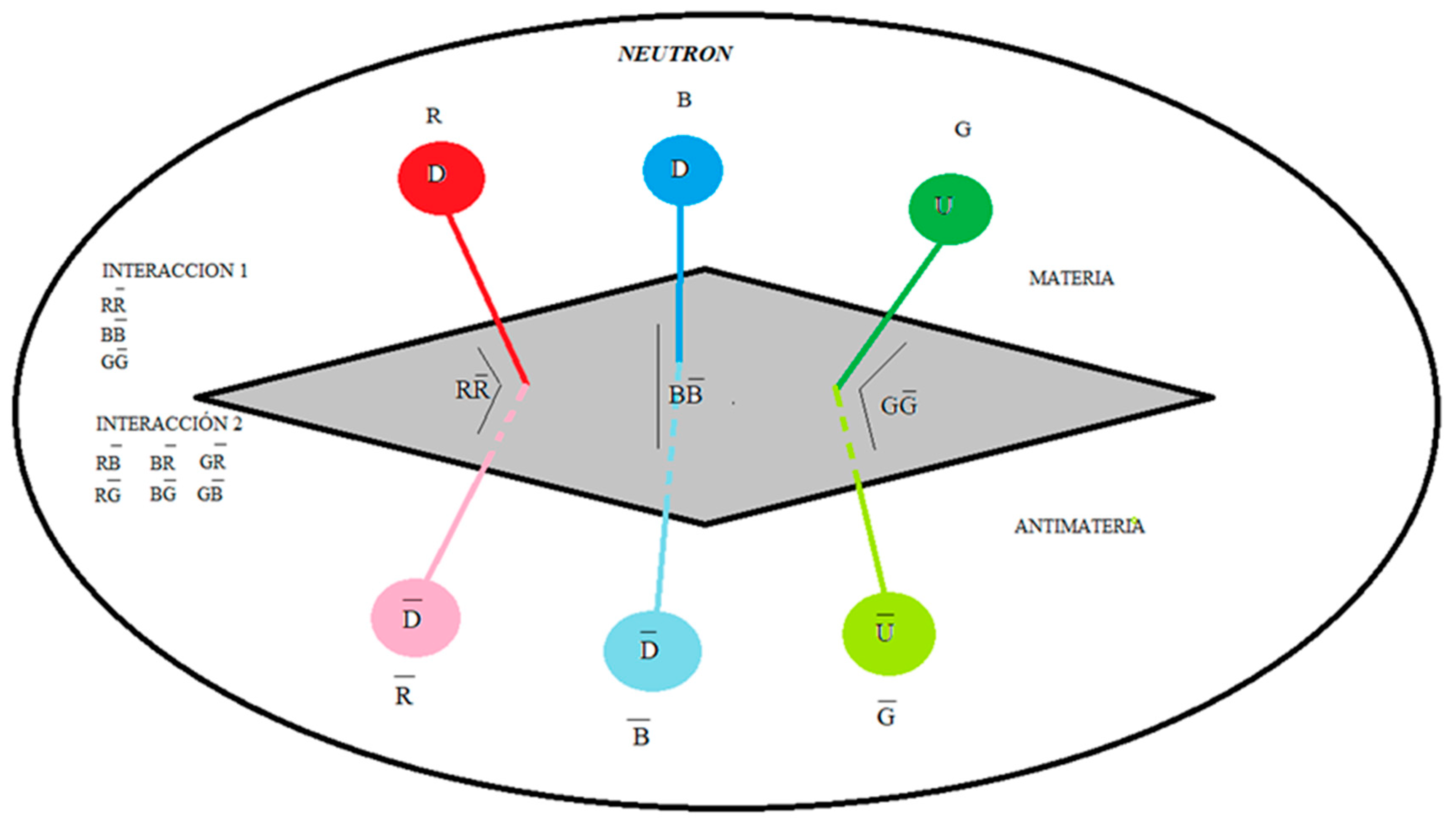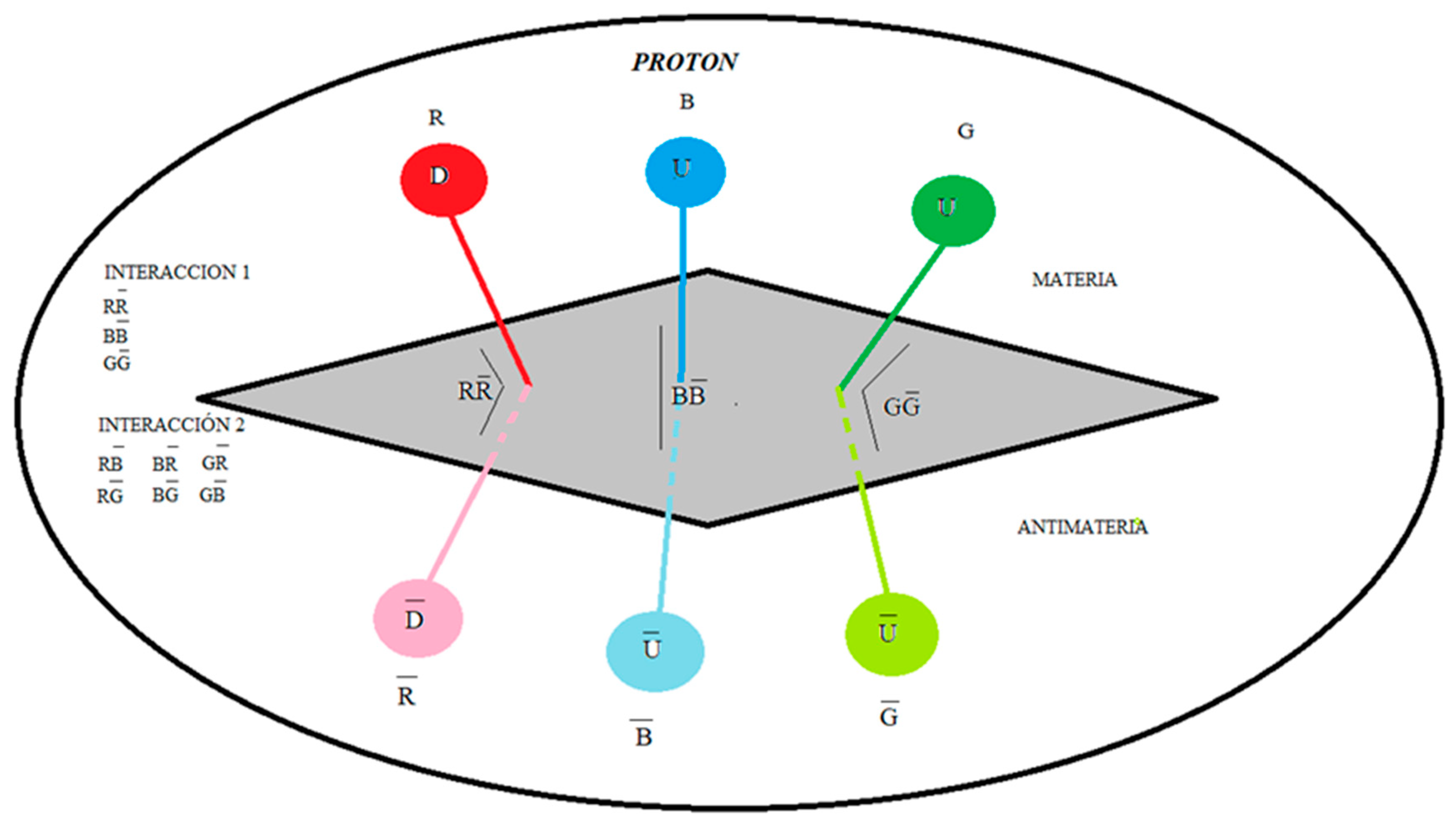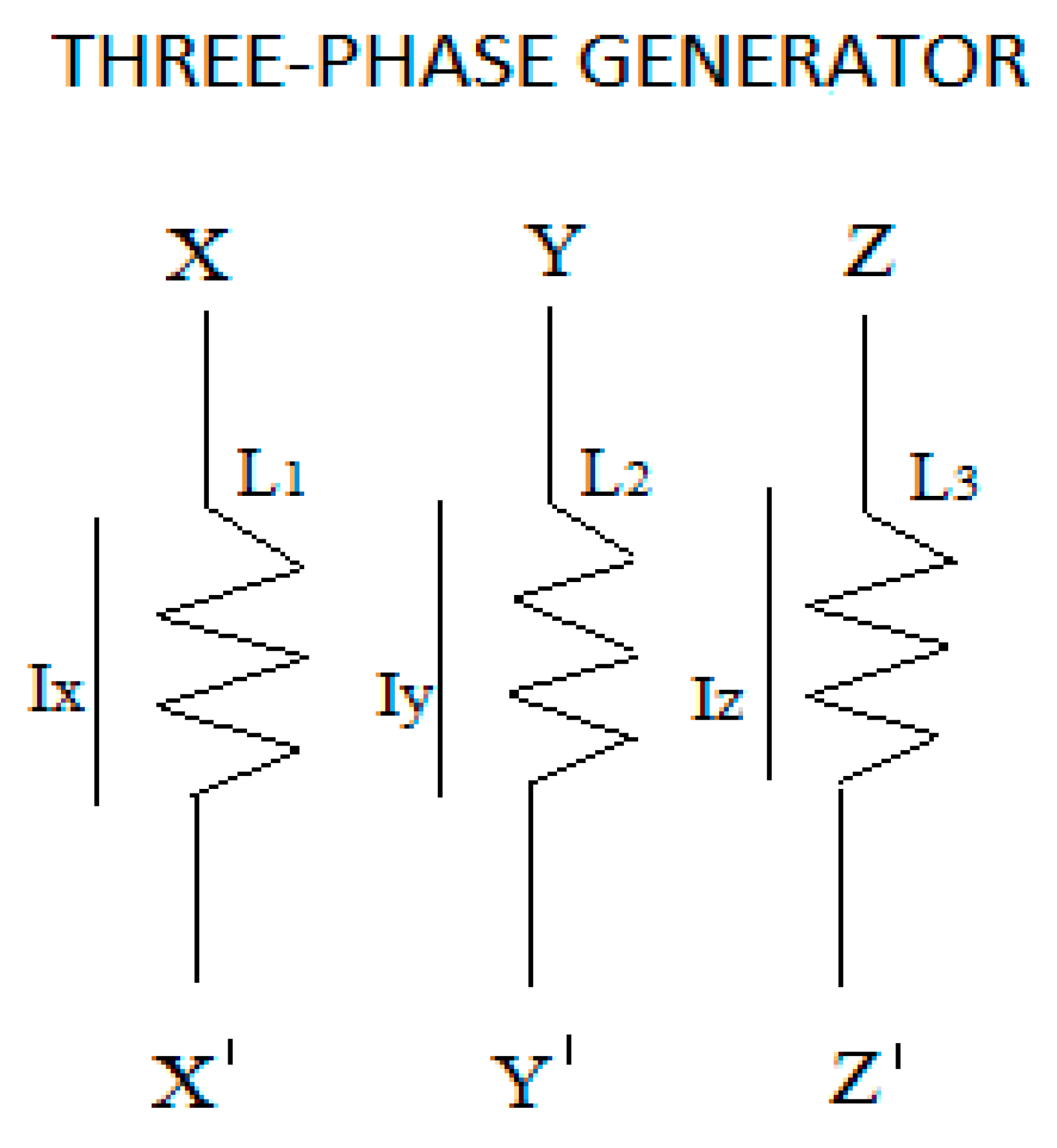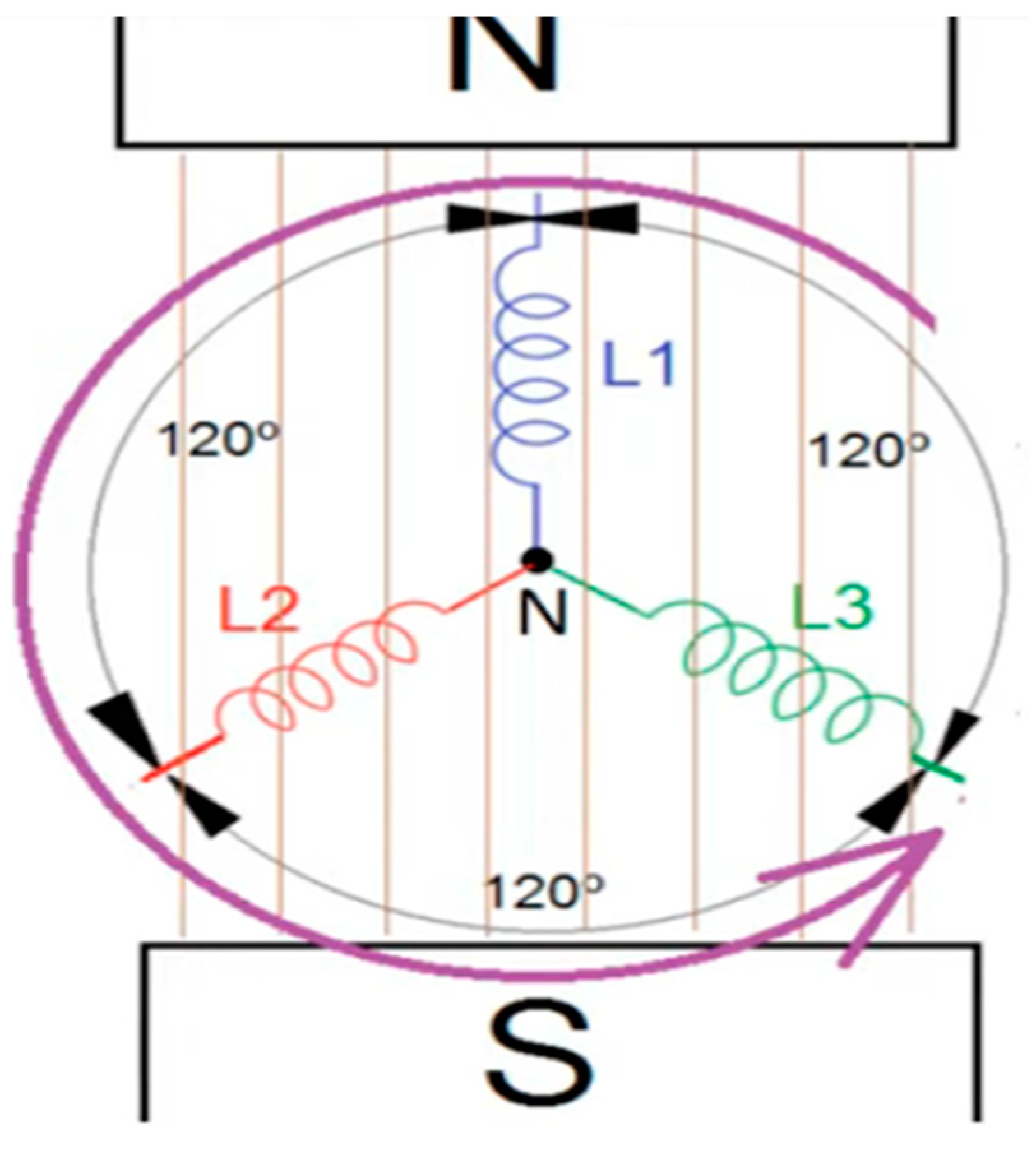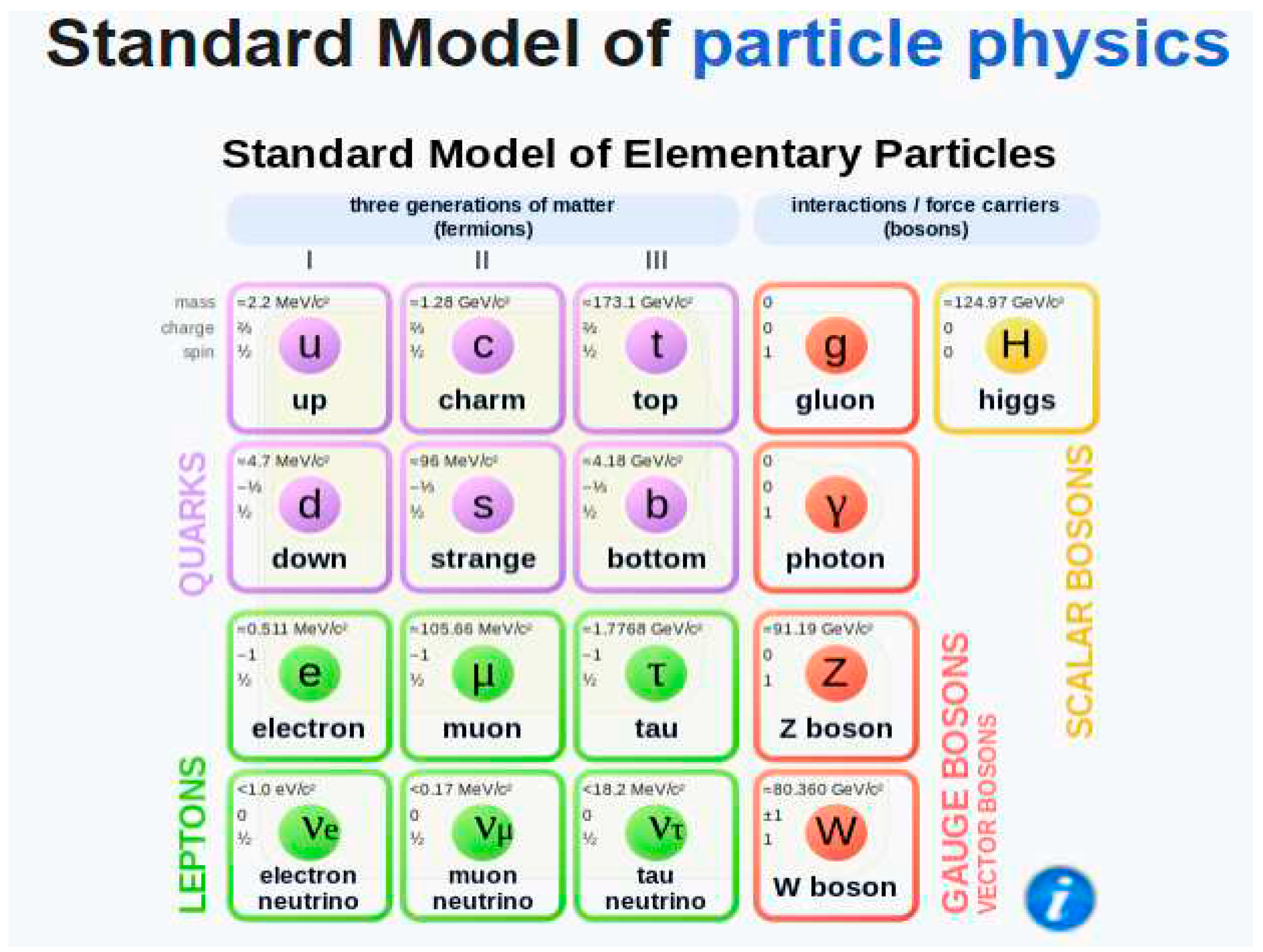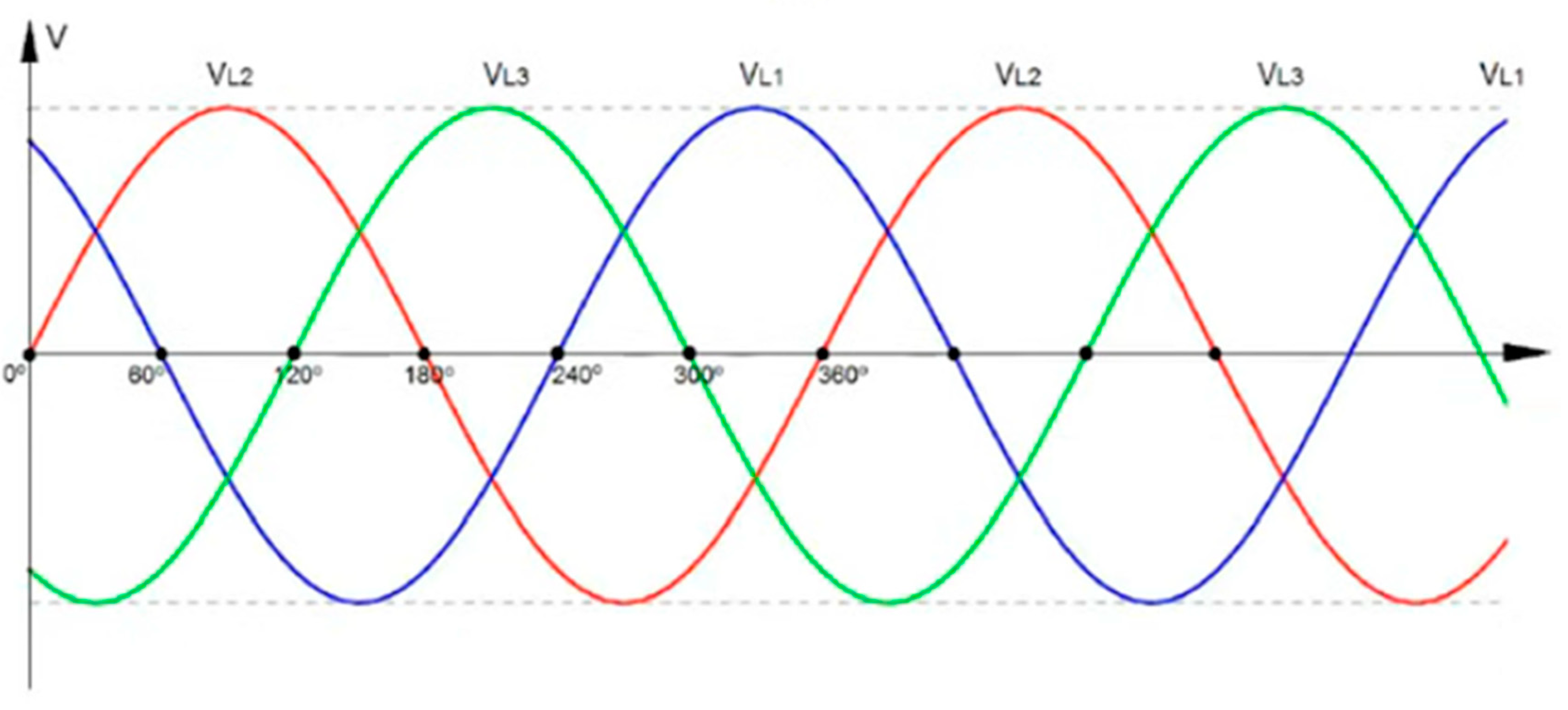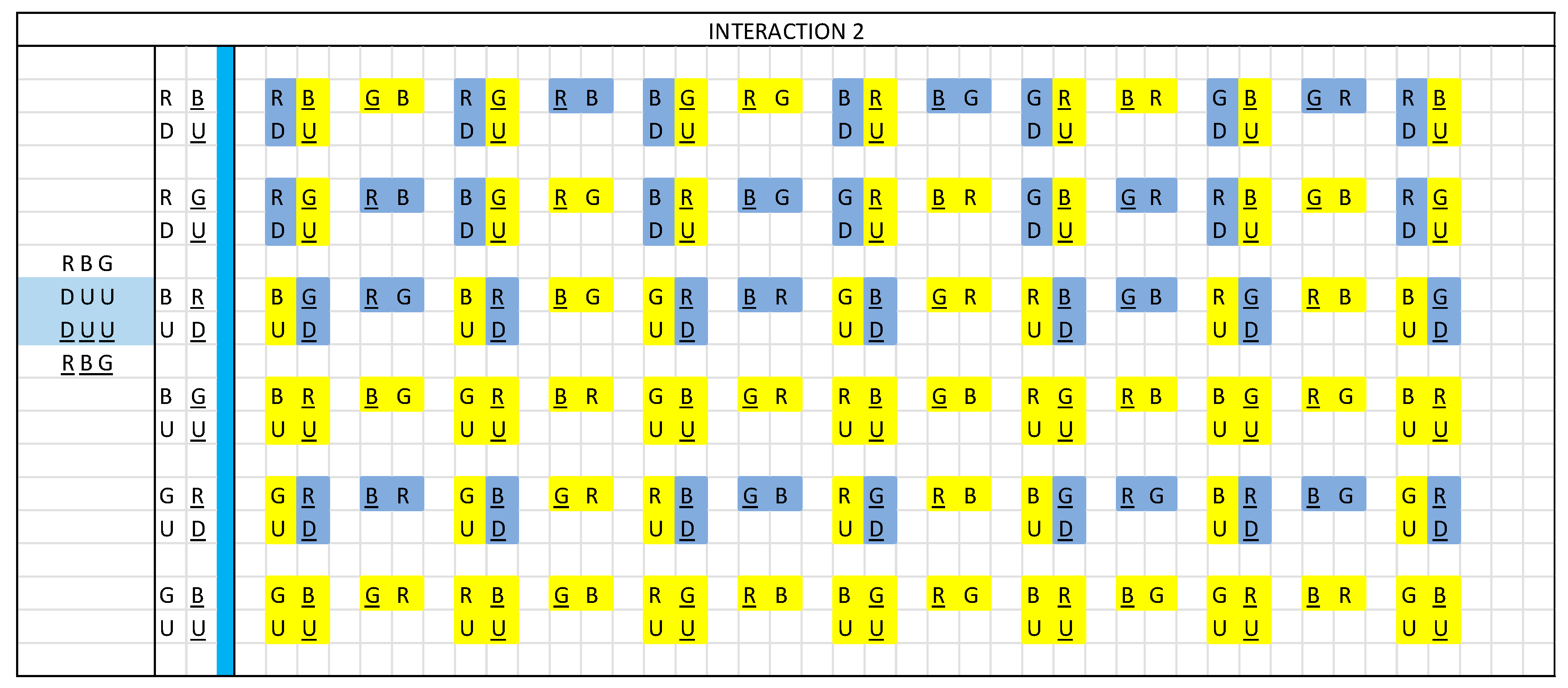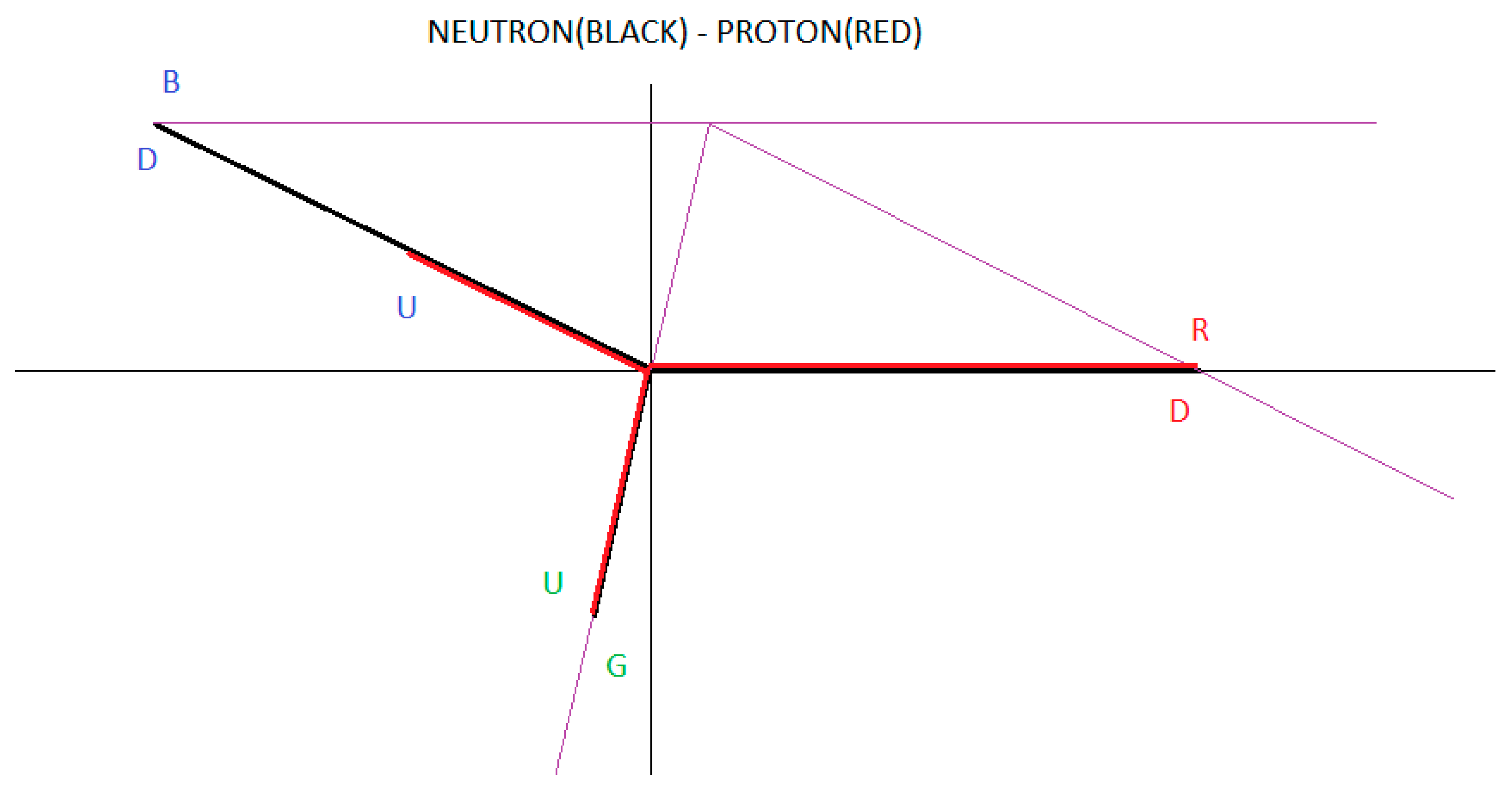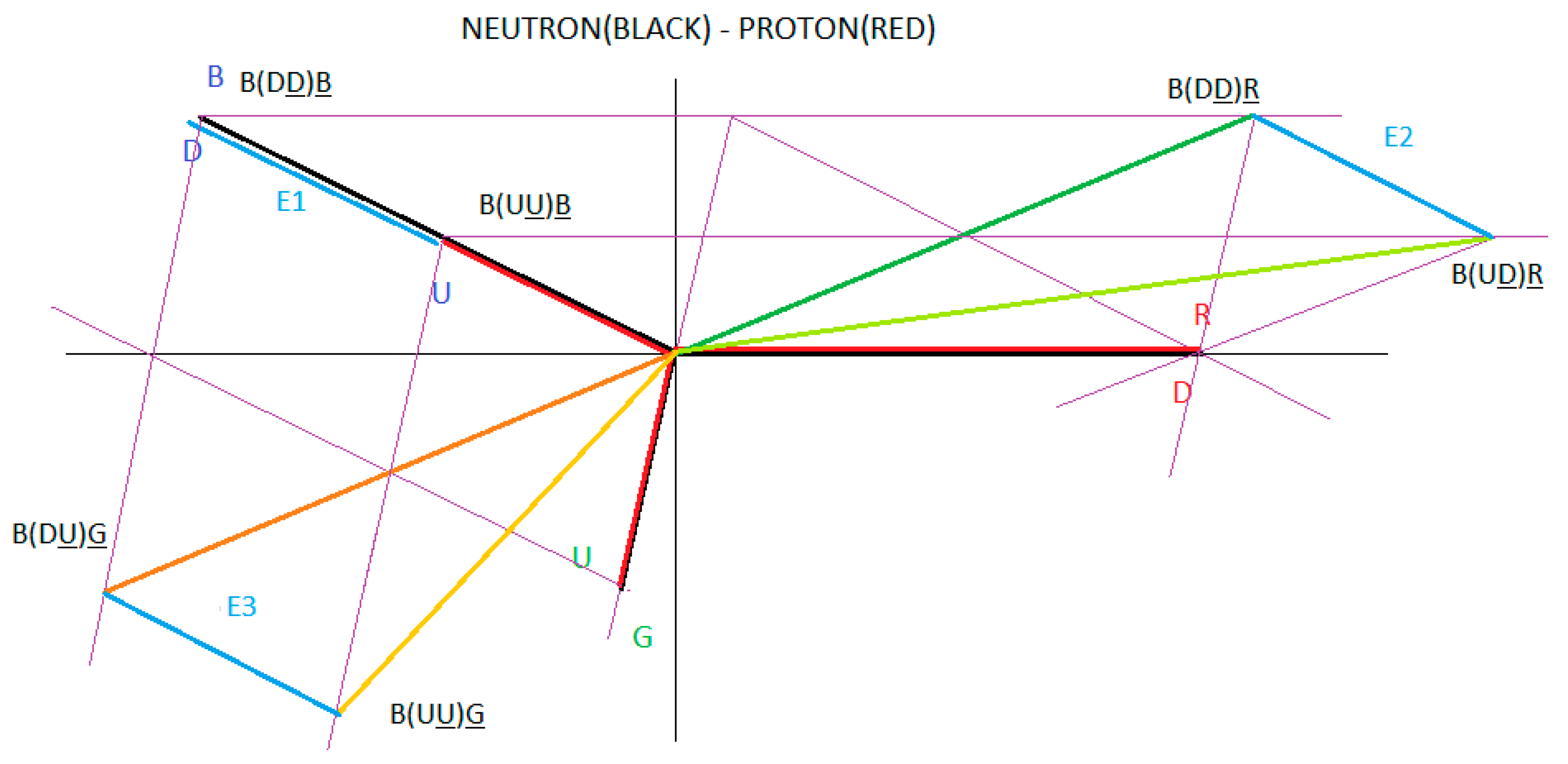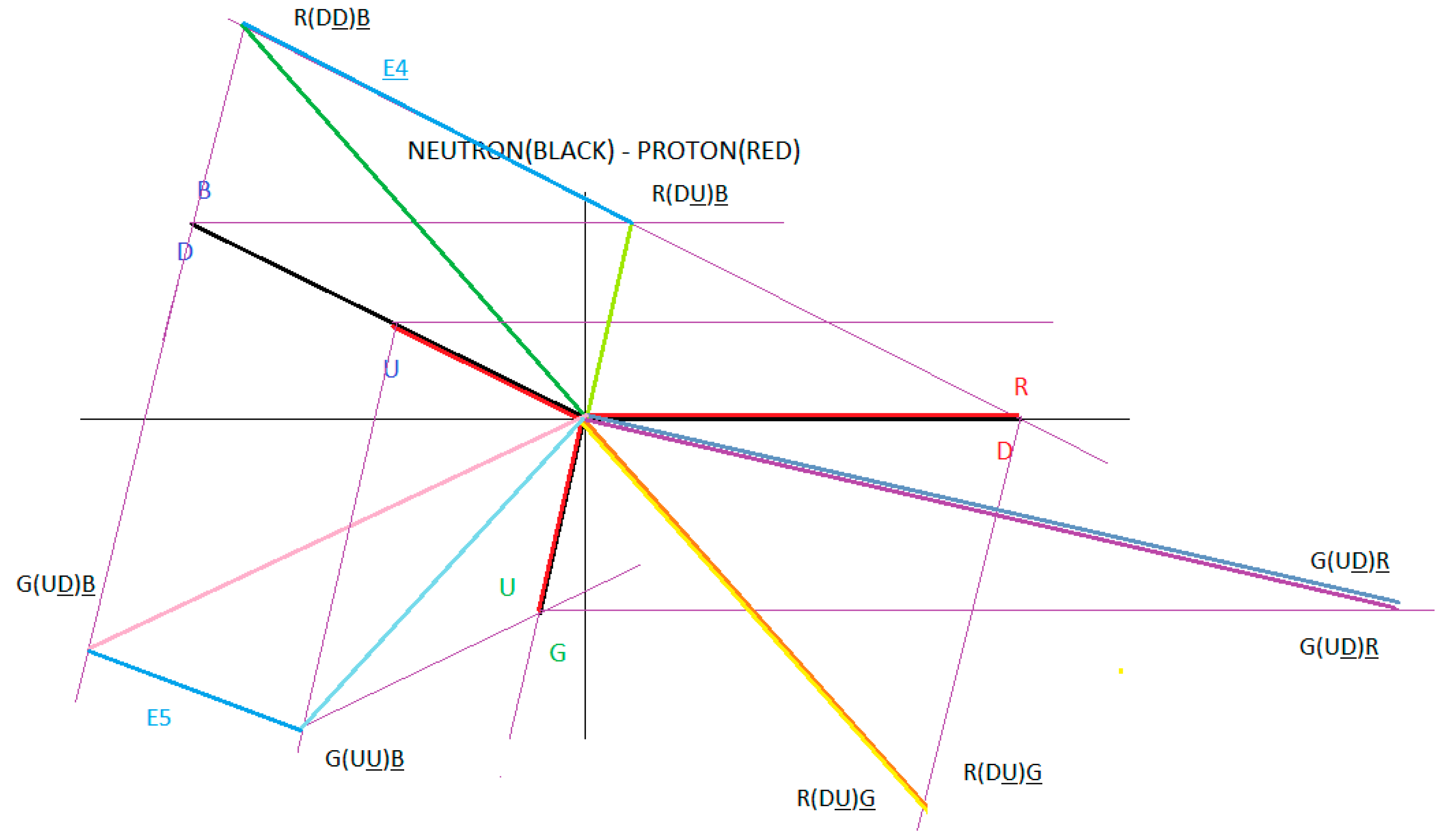1. Relationship between a three-phase electric generator and the quarks-antiquarks-gluons inside a neutron and proton
According to Max Planck, science is not only about discoveries, but also about changing the way we think, we should not be afraid of the unknown and we must feel free to follow our curiosity. Following this premise, we are going to develop this theory.
It is important to make clear that the interpretation we use of the structure of quarks does not correspond to QCD theory, it is a personal interpretation. In other words, this theory is outside the formal theory of quarks and gluons (QCD), it is totally personal.
The main idea is to try to demystify the realm in which quark-antiquark-gluon interactions dominate, presenting an alternative theory that contributes to the formal QCD theory.
Whenever we analyse scientific literature, articles, papers, that are related to collisions of subatomic particles, we see that in the collisions of subatomic particles, pairs of particles of matter and antimatter are produced, this always happens, fulfilling the principle of conservation of energy.
Taking into account what has been stated, we are going to consider matter and antimatter, to develop our theory. We are going to propose the following model for the neutron and the proton.
Here we put forward the hypothesis for a neutron, as a quark-antiquark-gluon interaction, and not as represented in the formal theory of QCD, as a quark-gluon interaction. See
Figure 1
Where D corresponds to the D quark and D corresponds to the D antiquark.
Where U corresponds to the U quark and U corresponds to the U antiquark.
The gluon interaction is given by (R, B, G) and (R, B, G).
Here we put forward the hypothesis for a proton, as a quark-antiquark-gluon interaction, and not as represented in the formal theory of QCD, as a quark-gluon interaction. See
Figure 2.
Before continuing, let’s explain why the UU and DD dipoles do not annihilate each other.
When we developed the paper titled: Theory of the Generalization of the Boltzmann’s Constant in Curved Space-Time. Shannon-Boltzmann Gibbs Entropy Relation and the Effective Boltzmann’s Constant; at the end of the paper, we show that the up quark and down quark, with a temperature of the order of 10¹⁰ K, have a space-time contraction factor of the order of 10⁶, in other words, the space-time envelope that surrounds the quark acts as a shell, like a protection, preventing the U quark and the U antiquark from annihilating each other, the same happens with the D quark and its D antiquark. , avoiding its annihilation.
This happens only at the quark level, as matter increases in complexity, this space-time protection becomes weaker, which leads to matter-antimatter annihilation.
If we look at
Figure 3 and
Figure 4, which correspond to the electrical circuit of a three-phase generator, we see that the electrical circuit of a neutron represented in
Figure 1 and the electrical circuit of a proton represented in
Figure 2, have an identical diagram. Basically, the difference is the following, in a three-phase generator, the pairs, XX′, YY′ and ZZ′ have the same frequency and in the case of a proton and neutron the D
D pairs have twice the frequency of the U
U pairs.
In
Figure 5 we are going to represent the diagram of the standard model of particle physics.
In
Figure 6, it represents the characteristics of the up and down quark, we can see that the frequency of the down quark is approximately double that of the up quark.
If we rotate the rotor of a generator, this induces a variable magnetic field in the stator and this generates a three-phase sinusoidal voltage, out of phase by 120 degrees, as seen in
Figure 7, that is the operating principle of a generator.
In analogy to what happens in a generator, in the proton and the neutron, the DD dipoles vibrate at approximately twice the frequency of the UU dipoles. Continuing with the analogy, the dipoles, XX′, YY′ and ZZ′ in a generator would be analogous to the dipoles DD, DD and UU in a neutron and the dipoles DD, UU and UU in a proton.
If we consider that the voltages, VL1, VL2 and VL3 are the result of rotating the rotor, which produces a variation of the magnetic field and ends up inducing and generating the voltages in the stator, continuing with the analogy, we can say that the dipoles DD, DD and UU in a neutron and the dipoles DD, UU and UU in a proton, is the result of a variable magnetic field that is generated from the interaction of quarks and anti-quarks with gluons, precisely this mechanism makes protons and neutrons generate their mass and are self-sustaining, this is the mechanism that allows the existence of hadrons.
Let us remember that Maxwell’s fourth law does not say that a variable magnetic field produces a variable electric field and thus repeats itself indefinitely, precisely through this mechanism a photon is self-sustaining, we can say that a photon has infinite life, and we can confirm this with the CMB which is the result of primordial photons.
the dipoles DD, DD and UU in a neutron and the dipoles DD, UU and UU in a proton, are also out of phase with a phase angle that we are going to determine, the nomenclature of the gluons (R, B, G) and (R, B, G) serves to remind us that the Interactions between quarks and gluons are vectors.
Taking into account the statement, in
Figure 8 and
Figure 9 we are going to represent the intrinsic interactions of the neutron and the proton.
Figure 8 and
Figure 9 represent the interactions that exist in a neutron and a proton, divided into interaction 1 and interaction.
Interaction 1 represents direct interactions between quarks and antiquarks and interaction 2 represents cross interactions between quarks and antiquarks.
Next, we are going to analyse the frequency; We said that in a three-phase generator, the frequency is always the same, we also said that the frequency of the down quark is approximately double the frequency of the up quark. We are going to analyse precisely that difference in frequency and its interpretation.
The analysis that we are going to perform is important for the following reason, when we perform a vector or phasor operation that has the same frequency, we do not have problems, but what happens if we are going to perform a vector or phasor operation with operators that have different frequencies. In this analysis we are going to answer this question!!!!!!
If we analyse
Figure 9 - proton, we observe that interaction 1 between quarks and antiquarks, direct interaction, are carried out at the same frequency.
Again, if we analyse
Figure 9, proton, we observe that interaction 2 between quarks and antiquarks, cross interaction, in analogy with interaction 1, the frequency difference between quarks and antiquarks, does not represent a drawback in energy exchanges.
In
Figure 10 we represent the energy exchanges between quarks and antiquarks and we see how the gluons act.
In blue we represent the quarks with the frequency of the Down quark and the associated gluon also in blue, when the energy exchange is carried out so that one quark becomes another quark.
In yellow we represent the quarks with the frequency of the up quark and the associated gluon also in yellow, when the energy exchange is carried out, so that one quark becomes another quark.
We can represent the statement in
Figure 11. We see why the exchange of gluons so that one quark becomes another quark does not represent a problem with frequency.
Quark U B transform quarks U G through gluon exchange G B, at the up-quark frequency, yellow.
Quark D R transform quarks D B through gluon exchange R B, at the down quark frequency, blue.
Taking into account what has been analysed so far, we can propose vector or phasor operations as valid, in analogy to that of a three-phase alternating current generator, which works with a single frequency.
It is the exchange of gluons, which is carried out at the appropriate frequency, allowing one quark to become another quark; it is this mechanism that allows us to perform a vector or phasor sum, as if this entire mechanism worked at a single frequency.
2. Electrical-quantum modelling of the neutron as a three-phase alternating current electrical generator.
We are going to work with
Figure 12 to create our electrical model of the neutron as a three-phase alternating current electrical generator.
The dipole DD is analogous to L1 and RR is analogous to the current flowing through L1.
The dipole DD is analogous to L2 and BB is analogous to the current flowing through L2.
The dipole UU is analogous to L3 and GG is analogous to the current flowing through L3.
We see that there are two types of interactions.
Interaction 1 or direct interaction and interaction 2 or cross interaction.
We said that down quarks have one frequency and up quarks have another frequency; Thanks to gluons, vector or phasor operations cease to be a problem, making it possible for a quark to transform into another quark, of the same frequency, thanks to the exchange of gluons. It is an amazing mechanism. We can see this mechanism in
Figure 10.
In analogy to a three-phase alternating current electric generator, we are going to represent interaction 1 and interaction 2, using vectors whose resulting vector is null. In this way, we are going to simulate a neutron as a three-phase alternating current electrical generator.
In
Figure 5 of the standard model, we see that the up quark has a mass of 2.2 MeV/c² and the down quark has a mass of 4.7 MeV/c².
Taking these values as reference we are going to make our vector diagram of the neutron.
Quark Down = 4.7 MeV/c²
Quark up = 2.2 MeV/c²
It is important to make it clear that all interactions are vector, although we do not represent them as such in the figures.
Interaction 1:
If we analyse
Figure 13, star connection, we see that the following vector sum is null:
R(DD)R + B(DD)B + G(UU)G = 0
If we analyse
Figure 13, triangle connection, we see that the following vector sum is null:
R(DD)B + B(DU)G + R(DU)G = 0
This is telling us that the net charge in interaction 1 is zero.
Figure 13.
– interaction 1 of the neutron.
Figure 13.
– interaction 1 of the neutron.
Interaction 2:
If we analyse
Figure 14, we observe that the following vector sum is also null:
R(DD)B + R(DU)G + B(DD)R + B(DU)G + G(UD)R + G(UD)B = 0
This is telling us that the net charge in interaction 2 is zero.
Taking into account interaction 1 and interaction 2, the total net charge of the neutron is zero, as appropriate.
Figure 14.
– Interaction 1 & 2 of the neutron.
Figure 14.
– Interaction 1 & 2 of the neutron.
Knowing that the total mass of the neutral is 939.5 MeV/c², we are going to calculate the mass content in each interaction:
R(DD)R = 85.7 MeV/c²
B(DD)B = 85.7 MeV/c²
G(UU)G = 40.2 MeV/c²
R(DD)B = 99 MeV/c²
R(DU)G = 99 MeV/c²
B(DD)R = 99 MeV/c²
B(DU)G = 99 MeV/c²
G(UD)R = 165.9 MeV/c²
G(UD)B = 165.9 MeV/c²
We are going to represent these values in
Figure 15:
The electrical modelling of a neutral as a three-phase alternating current electrical generator allows us to assign a mass value to interactions 1 & 2, which we represent using a phasor diagram, as shown in
Figure 14. It also allows us to verify that the sum of net charge in interactions 1 & 2 is zero, as appropriate.
Analysing the vector diagrams in
Figure 13 and
Figure 14, we see that the degrees of freedom of the vectors are practically zero, there is no possibility of deviations, the hypothesis that the charge has to be zero restricts any possibility of changes in the position of the vectors, that is, the vectors have a unique configuration, given in
Figure 13 and
Figure 14.
Conclusions: It is important to keep in mind that the relationship between the interactions of quarks, anti-quarks and gluons is vector-type, that is, each interaction will be represented by a module and an angle.
In the neutron, if we add the phasors of interaction 1 and interaction 2 vector-wise, we see that the resulting vector is zero, in other words, the net charge is zero; but if we add the module of each vector in MeV/c² scalarly, the sum gives us 939.5 MeV/c², we represent this in
Figure 14 and
Figure 15, which corresponds to the neutron.
Definitely, we can assure that neutrons are true generators of energy, mass and gravity; We have verified how with three quarks that add up to approximately 10 MeV/c², we can generate a mass of 939.5 MeV/c² through the interactions of quarks, anti-quarks and gluons.
2.1. Mechanism that generates mass in neutrons, calculation of the number of quarks-antiquarks-gluons inside a neutron
If we look at
Figure 15, we see that the neutron has a mass of 939.5 MeV/c², if we add the mass of the two D Quark and the mass of the U quark it gives us approximately 10 MeV/c²; We ask ourselves, how is the mass of 929 MeV/c² generated? That is precisely what we want to answer in this section.
If we look at
Figure 15, we see that we can represent the neutron by dipoles of matter and antimatter formed by quark and anti-quark. Interaction 1 can be represented by 3 dipoles and interaction 2 can be represented by 6 dipoles.
If we analyse any dipole, we see that at one end it is formed by matter and at the other end by antimatter, opposite charges of the opposite sign.
These dipoles behave like electrical antennas, if we consider that these dipoles move in one direction, they vibrate, they are polarized, they generate an electromagnetic field in analogy to the dipoles of antennas.
The variation of the electric field in the antennas produces a variation in the electric potential and this in turn produces a flow of current, thus generating an electromagnetic wave.
In analogy to dipole antennas, polarized vibrations in one direction produce a flow of gluons that carry charge, producing a current that would generate an electromagnetic field. This flow of charge-carrying gluons would be analogous to a flow of current and this would produce an electromagnetic field generated by the matter-antimatter dipole.
We know through the equation E = mc², that energy is related to mass and precisely that energy that results from gluonic exchange is the energy that generates the mass 929 MeV/c² in a neutron.
Neutron mass = 939.56 MeV/c²
2md + mu = 11.6 MeV/c²
where md is the mass of the D quark and mu is the mass of the U quark.
Gluon exchange mass = 928 MeV/c²
We are going to perform the following calculations:
We are going to work with the bond energy that keeps the electron attached to the proton, in the hydrogen atom.
13.6 eV = 2.17 10⁻¹⁸ Joules
E = h x f; f = E/h = 2.17 10⁻¹⁸ / 6.63 10⁻³⁴
f = 3.2 10¹⁵ Hz
E = K x T; T = E/K = 2.17 10⁻¹⁸ / 1.38 10⁻²³
T = 1.57 10⁵ K
M(photon) = h / (λ x C)
c = λ x f; λ = c/f = 3 10⁸ / 3.210¹⁵ = 0.937 10⁻⁷
λ = 9.37 10⁻⁸ m
M(photon) = h / (λ x C) = 6.63 10⁻³⁴ / 9.37 10⁻⁸ x 3 10⁸
M(photon-gluon) = 2.35 10⁻³⁵ kg
That would be the mass of the photon-gluon that holds the electron to the proton in the hydrogen atom.
Let’s assume that the binding energy is 136,000 eV:
136,000 eV = 2.17 10⁻¹⁴ Joules
E = h x f; f = E/h = 2.17 10⁻¹⁴ / 6.63 10⁻³⁴
f = 3.2 10²⁰ Hz
E = K x T; T = E/K = 2.17 10⁻¹⁴ / 1.38 10⁻²³
T = 1.57 10⁹ K
M(photon) = h / (λ x C)
c = λ x f; λ = c/f = 3 10⁸ / 3.2 10²⁰ = 0.937 10⁻¹²
λ = 9.37 10⁻¹³ m
M(photon) = h / (λ x C) = 6.63 10⁻³⁴ / 9.37 10⁻¹³ x 3 10⁸
M(photon-gluon) = 2.35 10⁻³⁰ kg
Let’s assume that the binding energy is 1,360,000,000 eV:
1,360,000,000 eV = 2.17 10⁻¹⁰ Joules
E = h x f; f = E/h = 2.17 10⁻¹⁰ / 6.63 10⁻³⁴
f = 3.2 10²³ Hz
E = K x T; T = E/K = 2.17 10⁻¹⁰ / 1.38 10⁻²³
T = 1.57 10¹³ K
M(photon-gluon) = h / (λ x C)
c = λ x f; λ = c/f = 3 10⁸ / 3.2 10²³ = 0.937 10⁻¹⁵
λ = 9.37 10⁻¹⁶ m
M(photon) = h / (λ x C) = 6.63 10⁻³⁴ / 9.37 10⁻¹⁶ x 3 10⁸
M(photon-gluon) = 2.35 10⁻²⁷ kg
Let’s assume that in a hydrogen atom the electron is linked to the proton through the BB gluons, which are analogous to photons and can escape confinement, in addition, the rest of the gluons have colour charge other than zero, they cannot escape confinement. We can consider that in general from the point of view of energy, for the same temperature conditions all gluons have equivalent energies of the same order.
Later, when we analyse βˉ decay, we will show that a neutron decays into a proton and if the released electron is trapped forming the hydrogen atom, we will see that the BB gluons would be the linked photons in the electromagnetic theory, that unites the proton with the electron
With the calculations carried out, we are going to generate the following table:
In
table 1, we observe that as the energy increases, the frequency increases, the temperature increases and consequently the mass of the gluon increases.
If we remember what we said that neutrons and protons are formed by dipoles of matter and antimatter (quark and anti-quark), which oscillate in a certain direction similar to the electric dipoles in antennas, if we analyse
table 1, we see that as the dipoles increase their vibration frequency, their energy increases, their temperature increases and the mass of the gluon also increases as predicted.
If we look at
table 1, for T = 1.57 10⁹ K, we see that the mass of the gluons is approximate to the mass of the U quark and D quark, shown in
Figure 6. This is telling us that if we consider the correct temperature, the mass of the gluons will coincide with the mass of the U quark and D quark.
mu = 4.10 10ˉ³⁰ kg, T = 2.67 10¹⁰ K
md = 8.55 10ˉ³⁰ kg, T = 5.57 10¹⁰ K
Gluon mass = 2.35 19ˉ³⁰ kg, T = 1.57 10⁹ K
Taking into account the statement:
We are going to perform the following calculation:
Neutron mass = 939.56 MeV/c²
2md + mu = 11.6 MeV/c²
Number of gluons = neutron mass / unit mass of a gluon
For T = 1.57 10⁵ K:
Approximate number of gluons per neutron = 1.67 10⁻²⁷ / 2.35 10⁻³⁵
Approximate number of gluons per neutron = 0.71 10⁸
QTY g = 7.1 10⁷ = 71,000,000.00
71 million gluons in a neutron, for T = 1.57 10⁵ K.
Where QTY g, is the number of gluons inside a neutron.
When we talk about gluons, we refer to quarks-antiquarks and gluons as a whole, as long as the interaction relationship 1 & 2 is fulfilled, as shown in
Figure 15.
According to
table 1, we see that the number of gluons in a neutron depends on the temperature (energy) at which the calculation is carried out.
Looking at
table 1, we see that as the temperature increases, the mass of the quark-gluons increases, for example, for a temperature of 10⁹ K, the mass of a quark-gluon is in the order 10ˉ³⁰ kg. Now, for a temperature of 10¹³ K, the mass of the quark-gluons is on the order of 10ˉ²⁷ kg.
Next, we are going to calculate the quantity of quarks-antiquarks-gluons existing, in a discriminated manner, in the dipoles of the interaction 1 & 2.
Interaction 1:
QTY g INT 1: = 0.376 10ˉ²⁷ kg / 2.35 10ˉ³⁵ kg = 1.6 10⁷ Q-Gluons
Qty g R(DD)R = 0.152 10ˉ²⁷ kg / 2.35 10ˉ³⁵ kg = 0.648 10⁷ Q-Gluons
Qty g B(DD)B = 0.152 10ˉ²⁷ kg / 2.35 10ˉ³⁵ kg = 0.648 10⁷ Q-Gluons
Qty g G(UU)G = 0.072 10ˉ²⁷ kg / 2.35 10ˉ³⁵ kg = 0.306 10⁷ Q-Gluons
Interaction 2:
QTY g INT 2 = 1.293 10ˉ²⁷ kg / 2.35 10ˉ³⁵ kg = 5.50 10⁷ Q-Gluons
QTY g R(DD)B = 0.1759 10ˉ²⁷ kg / 2.35 10ˉ³⁵ = 0.748 10⁷ Q-Gluons
QTY g R(DU)G = 0.1759 10ˉ²⁷ kg / 2.35 10ˉ³⁵ = 0.748 10⁷ Q-Gluons
QTY g B(DD)R = 0.1759 10ˉ²⁷ kg / 2.35 10ˉ³⁵ = 0.748 10⁷ Q-Gluons
QTY g B(DU)G = 0.1759 10ˉ²⁷ kg / 2.35 10ˉ³⁵ = 0.748 10⁷ Q-Gluons
QTY g G(UD)R = 0.294 10ˉ²⁷ kg / 2.35 10ˉ³⁵ = 1.254 10⁷ Q-Gluons
QTY g G(UD)B = 0.294 10ˉ²⁷ kg / 2.35 10ˉ³⁵ = 1.254 10⁷ Q-Gluons
Where Q-Gluons, it means quarks-antiquarks-gluons.
It is very important to be clear that the mass of quark-antiquarks-gluons varies with temperature.
These calculations were carried out for a temperature T = 1.57 10⁵ K.
2.1.1. Calculation of the number of gluons by dividing the volume of the neutron by the volume of the quark.
Rn = 0.4 10ˉ¹⁵ m
Where Rn is radius of the neutron
Vn = (4/3) ᴨ R³ = (4/3) x 3.14 x (0.4 10ˉ¹⁵) ³
Vn = 0.267 10ˉ⁴⁵ m³
Rq = 0.43 10⁻¹⁸ m
Where Rq is quark radius.
Vq = (4/3) ᴨ R³ = (4/3) x 3.14 x (0.43 10⁻¹⁸) ³ =
Vq = 0.33 10⁻⁵⁴ mᶾ
Where Vq is volume of the quark
D = Vn / Vq = 0.267 10ˉ⁴⁵ m³ / Vq = 0.33 10⁻⁵⁴ mᶾ
D = 0.80 10⁹ = 8.0 10⁸
D = 80 10⁷ gluons
Where D is the number of quark-antiquarks-gluons
According to our calculations, we have:
D ≈ 10 QTY g
We said that the mass of gluons decreases with temperature, see
table 1, if we calculate the number of quarks-antiquarks-gluons for a temperature lower than T = 10⁵ K, we will achieve the equality D = QTY g.
D = 10 QTY g
2.2. Mechanism that generates gravity in neutrons, calculation of the number of gravitons inside a neutron
From the point of view of charge, we said that interaction 1 and interaction 2 of quarks represent electric dipoles (Spin 1). We also said that these dipoles are polarized and vibrate in one direction, producing an electromagnetic field that gives rise to a flow of gluons that generates an electric current and through this mechanism we manage to produce mass in Hadrons (proton, neutron, etc).
From the point of view of mass, if we consider quark and anti-quark dipoles as point masses that vibrate, we can idealize it as a quark linked to an anti-quark by a spring (Gravitons with spin 2), these two masses vibrating together by a spring, they would produce disturbances in space-time that would propagate in the form of gravitational waves.
This would be the mechanism by which gravitational waves are generated, gravitons that would propagate in space-time.
In conclusion, it is the charge and mass properties in the quark and anti-quark dipoles represented in interaction 1 and interaction 2, which produce 100% of the mass in protons and neutrons and also cause the gravitational waves (gravitons), that propagate in space-time, what we call gravity.
Neutron mass = 939.56 MeV/c²
2md + mu = 11.6 MeV/c²
where md, is the mass of the D quark and mu, is the mass of the U quark.
We are going to perform the following calculations using the effective Boltzmann constant to quantize and quantify gravity.
Kʙl = 9.15 10⁻²⁶ J/K,
Where Kʙl is approximate effective Boltzmann constant of the moon.
El = Kʙl x T
El = 9.15 10⁻²⁶ x 1.6 10³ = 14.64 x 10⁻²³
El = 14.64 10⁻²³ Joules
El = h x fl; fl = El / h = 14.64 10⁻²³ / 6.63 10⁻³⁴ = 2.34 10¹¹
fl = 2.34 10¹¹ Hz
M(graviton) = h / (λl x c)
c = λl x fl; λl = c / fl = 3 10⁸ / 2.34 10¹¹ = 1.28 10⁻³
λl = 1.28 10⁻³ m
M(graviton) = h / (λl x c) = 6.63 10⁻³⁴ / 1.28 10⁻³ x 3 10⁸ = 1.72 10⁻²⁹
M(graviton)l-eff = 1.72 10⁻²⁹ kg
Kʙt = 2.68 10⁻²⁸ J/K,
Where Kʙt is approximate effective Boltzmann constant of the earth.
Et = Kʙt x T
Et = 2.68 10⁻²⁸ x 6.7 10³ = 17.95 x 10⁻²⁵
Et = 17.95 10⁻²⁵ Joules
Et = h x ft; ft = Et / h = 17.95 10⁻²⁵ / 6.63 10⁻³⁴ = 2.70 10⁹
Ft = 2.70 10⁹ Hz
M(graviton) = h / (λ x C)
c = λt x ft; λt = c/ft = 3 10⁸ / 2.70 10⁹ = 1.11 10⁻¹
λt = 11.1 10⁻¹ m
M(graviton) = h / (λt x c) = 6.63 10⁻³⁴ / 1.11 10⁻¹ x 3 10⁸
M(graviton)t-eff = 1.99 10⁻⁴¹ kg
Kʙs = 3.58 10⁻³⁷ J/K
Where Kʙs is approximate effective Boltzmann constant of the sun.
Es = Kʙs x T
Es = 3.58 10⁻³⁷ x 15 10⁶ = 53.7 x 10⁻³¹
Es = 53.7 10⁻³¹ Joules
Es = h x fs; fs = Es / h = 53.7 10⁻³¹ / 6.63 10⁻³⁴ = 8.09 10³
fs = 8.09 10³ Hz
M(graviton) = h / (λs x c)
c = λs x fs; λs = c / fs = 3 10⁸ / 8.09 10³ = 0.37 10⁵
λs = 3.7 10⁴ m
M(graviton) = 6.63 10⁻³⁴ / (3.7 10⁴ x 3 10⁸) = 0.59 10⁻⁴⁶
M(graviton)s-eff = 5.9 10⁻⁴⁷ kg
Kʙe = 1.9 10⁻³⁷ J/K
Where Kʙe is approximate effective Boltzmann constant of a star white dwarf.
Ee = Kʙe x T
Ee = 1.9 10⁻³⁷ x 20 10⁶ = 38 x 10⁻³¹
Ee = 38 10⁻³¹ Joules
Ee = h x fe; fe = Ee / h = 38 10⁻³¹ / 6.63 10⁻³⁴ = 5.73 10³
fe = 5.73 10³ Hz
M(graviton) = h / (λe x c)
c = λe x fe; λe = c / fe = 3 10⁸ / 5.73 10³ = 0.52 10⁵
λe = 5.2 10⁴ m
M(graviton) = h / (λe x c) = 6.63 10⁻³⁴ / 5.2 10⁴ x 3 10⁸ = 0.425 10⁻⁴⁶
M(graviton)e-eff = 4.25 10⁻⁴⁷ kg
Kʙn = 2.42 10⁻⁴² J/K
Where Kʙn is approximate effective Boltzmann constant of a neutron star.
En = Kʙn x T
En = 2.42 10⁻⁴² x 10¹² = 2.42 x 10⁻³⁰
En = 2.42 10⁻³⁰ Joules
En = h x fn; fn = En / h = 2.42 10⁻³⁰ / 6.63 10⁻³⁴ = 0.36 10⁴
fn = 3.6 10³ Hz
M(graviton) = h / (λn x c)
c = λn x fn ; λn = c / fn = 3 10⁸ / 3.6 10³ = 0.83 10⁵
λs = 8.3 10⁴ m
M(graviton) = h / (λn x c) = 6.63 10⁻³⁴ / 8.3 10⁴ x 3 10⁸ = 0.266 10⁻⁴⁶
M(graviton)n-eff = 2.66 10⁻⁴⁷ kg
Kʙq = 1.78 10⁻⁴³ J/K
Where Kʙq is approximate effective Boltzmann constant of a black hole.
Eq = Kʙq x T
Eq = 1.78 10⁻⁴³ x 10¹³ = 1.78 x 10⁻³⁰
Eq = 1.78 10⁻³⁰ Joules
Eq = h x fq; fq = Eq / h = 1.78 10⁻³⁰ / 6.63 10⁻³⁴ = 0.26 10⁴
fq = 2.6 10³ Hz
M(graviton) = h / (λq x c)
c = λq x fq ; λq = c / fq = 3 10⁸ / 2.6 10³ = 1.15 10⁵
λq = 1.15 10⁵ m
M(graviton) = h / (λq x c) = 6.63 10⁻³⁴ / 1.15 10⁵ x 3 10⁸ = 1.76 10⁻⁴⁷
M(graviton)q-eff = 1.76 10⁻⁴⁷ kg
We are going to represent all these calculations in
Table 2:
It is important to clarify that the mass of the calculated graviton is an effective mass or equivalent that is related to the definition that was used to calculate the effective Boltzmann constant, for example, in a neutron star the minimum particle considered to calculate the effective mass is a neutron and the effective graviton equivalent mass calculated for a neutron star is related to the mass of the neutron, that is, the graviton equivalent or effective mass calculated for a neutron star is a mass resulting from an unimaginable amount of individual gravitons.
In analogy with the calculations carried out for gluons, we are going to carry out similar calculations for gravitons using the mass of the effective graviton.
For a neutron star, we have:
Let’s assume the mass of the neutron for T= 10¹² K:
Neutron mass = 939.56 MeV/c²
2md + mu = 11.6 MeV/c²
QTY gr = Neutron mass / unit mass of a graviton.
QTY gr = 1.67 10⁻²⁷ / 2.66 10⁻⁴⁷
m gr = 2.66 10ˉ⁴⁷ kg
Where m gr, is the unit mass of the graviton for T = 10¹² K.
QTY gr = 0.627 10²⁰
QTY gr = 6.27 10¹⁹
Where QTY gr, is number of gravitons in a neutron, for T = 10¹² K.
Why do we use the mass of the neutron, mn = 939.56 MeV/c², to calculate the number of gravitons in a neutron!
This question, in my opinion, would have 2 answers:
First answer, from the point of view of mass, if we consider quark and anti-quark dipoles as point masses that vibrate, we can idealize it as a quark linked to an anti-quark by a spring (Gravitons with spin 2), these two masses vibrating together by a spring, they would produce disturbances in space-time that would propagate in the form of gravitational waves. This would be the mechanism by which gravitational waves are generated, gravitons that would propagate in space-time.
Second answer, if we consider the Maldacena correspondence ADS = CFT, the right side of the equation, CFT, tells us that there is a mass that corresponds to the neutron and is mn = 939.56 MeV/c²; The left side tells us that there must be a gravitational mass equivalent to mn = 939.56 MeV/c², which must be equivalent to the CFT mass, for the equation ADS = CFT to be fulfilled.
These are the two answers, for which we use the mass of the neutron to calculate the number of gravitons inside a neutron.
We will calculate the number of corresponding gravitons, for interactions 1 & 2:
Interaction 1:
QTY gr INT 1: = 0.376 10ˉ²⁷ kg / 2.66 10ˉ⁴⁷ kg = 1.41 10¹⁹ Graviton
Qty gr R(DD)R = 0.152 10ˉ²⁷ kg / 2.66 10ˉ⁴⁷ kg = 0.571 10¹⁹ Graviton
Qty gr B(DD)B = 0.152 10ˉ²⁷ kg / 2.66 10ˉ⁴⁷ kg = 0.571 10¹⁹ Graviton
Qty gr G(UU)G = 0.072 10ˉ²⁷ kg / 2.66 10ˉ⁴⁷ kg = 0.270 10¹⁹ Graviton
Interaction 2:
QTY gr INT 2 = 1.293 10ˉ²⁷ kg / 2.66 10ˉ⁴⁷ kg = 4.86 10¹⁹ Graviton
QTY gr R(DD)B = 0.1759 10ˉ²⁷ kg / 2.66 10ˉ⁴⁷ = 0.661 10¹⁹ Graviton
QTY gr R(DU)G = 0.1759 10ˉ²⁷ kg / 2.66 10ˉ⁴⁷ = 0.661 10¹⁹ Graviton
QTY gr B(DD)R = 0.1759 10ˉ²⁷ kg / 2.66 10ˉ⁴⁷ = 0.661 10¹⁹ Graviton
QTY gr B(DU)G = 0.1759 10ˉ²⁷ kg / 2.66 10ˉ⁴⁷ = 0.661 10¹⁹ Graviton
QTY gr G(UD)R = 0.294 10ˉ²⁷ kg / 2.66 10ˉ⁴⁷ = 1.105 10¹⁹ Graviton
QTY gr G(UD)B = 0.294 10ˉ²⁷ kg / 2.66 10ˉ⁴⁷ = 1.105 10¹⁹ Graviton
It is important to make it clear that the number of gravitons calculated inside a neutron corresponds to the temperature T = 10¹² K.
If we look at
table 2, we see that as the temperature increases the mass of the graviton decreases.
3. Electrical-quantum modelling of the proton as a three-phase alternating current electrical generator
We are going to work with
Figure 16 to create our electrical model of the proton as a three-phase alternating current electrical generator.
The dipole DD is analogous to L1 and RR is analogous to the current flowing through L1.
The dipole UU is analogous to L2 and BB is analogous to the current flowing through L2.
The dipole UU is analogous to L3 and GG is analogous to the current flowing through L3.
We see that there are two types of interactions.
Interaction 1 or direct interaction and interaction 2 or cross interaction.
We said that down quarks have one frequency and up quarks have another frequency; Thanks to gluons, vector or phasor operations cease to be a problem, making it possible for a quark to transform into another quark, of the same frequency, thanks to the exchange of gluons. It is an amazing mechanism. We can see this mechanism in
Figure 10.
In analogy to a three-phase alternating current electric generator, we are going to represent interaction 1 and interaction 2, using vectors whose resulting vector is not zero. In this way we are going to simulate a proton as a three-phase alternating current electrical generator.
In
Figure 5 of the standard model, we see that the up quark has a mass of 2.2 MeV/c² and the down quark has a mass of 4.7 MeV/c².
Taking these values as reference we are going to make our vector diagram of the neutral.
Quark Down = 4.7 MeV/c²
Quark up = 2.2 MeV/c²
It is important to make it clear that all interactions are vector, although we do not represent them as such in the figures.
Interaction 1:
If we analyse
Figure 17, star connection, we see that the following vector sum is not null:
R(DD)R + B(UU)B + G(UU)G ≠ 0
Figure 17.
– Proton interaction 1.
Figure 17.
– Proton interaction 1.
Interaction 2:
If we analyse
Figure 18, we observe that the following vector sum is not null:
R(DU)B + R(DU)G + B(UD)R + B(UU)G + G(UD)R +G(UU)B ≠ 0
From a load point of view, we have:
R(DD)R + B(UU)B + G(UU)G + R(DU)B + R(DU)G + B(UD)R + B(UU)G + G(UD)R
+ G(UU)B = 1
From the mass point of view, we have:
R(DD)R + B(UU)B + G(UU)G + R(DU)B + R(DU)G + B(UD)R + B(UU)G + G(UD)R
+ G(UU)B = 938.27 MeV/c²
Figure 18.
- Interaction 1 & 2 of the proton.
Figure 18.
- Interaction 1 & 2 of the proton.
Knowing that the total mass of the proton is 938.27 MeV/c², we are going to calculate the mass content in each interaction:
R(DD)R = 103.22 MeV/c²
B(UU)B = 48.34 MeV/c²
G(UU)G = 48.34 MeV/c²
R(DU)B = 48.34 MeV/c²
R(DU)G = 122.55 MeV/c²
B(UD)R = 161.23 MeV/c²
B(UU)G = 103.22 MeV/c²
G(UD)R = 199.80 MeV/c²
G(UU)B = 103.22 MeV/c²
We are going to represent these values in
Figure 19:
The electrical modelling of a proton as a three-phase alternating current electrical generator allows us to assign a mass value to interactions 1 and 2, which we represent using a vector diagram, as shown in
Figure 18 and
Figure 19.
Conclusions: It is important to keep in mind that the relationship between the interactions of quarks, anti-quarks and gluons is vector-type, that is, each interaction will be represented by a module and an angle.
Definitely, we can assure that protons are true generators of energy, mass and gravity; We have verified how with three quarks that add up to approximately 10 MeV/c², we can generate a mass of 938.27 MeV/c² through the interactions of quarks, anti-quarks and gluons.
4. APPLICATION OF THE MODEL AND RESULTS
4.1. Analysis of βˉ decay. Creation of electrons, neutrinos and photons.
Let’s briefly describe βˉ decay:
Beta decay or β decay represents the decay of a parent nucleus to a daughter through the emission of the beta particle. Beta decay is governed by the weak interaction.
This transition (βˉ decay) can be characterized as:
If a nucleus emits a beta particle, it loses an electron (or positron). In this case, the mass number of the daughter nucleus remains the same, but the daughter nucleus will form a different element.
A free neutron also undergoes this type of decay. A free neutron will decay with a half-life of approximately 611 seconds (10.3 minutes) into a proton, an electron, and an antineutrino.
Figure 21.
- weak interaction changes one quark flavour to another.
Figure 21.
- weak interaction changes one quark flavour to another.
The electrons emitted in beta decay have a continuous rather than discrete spectrum that seems to contradict the conservation of energy, under the current assumption that beta decay is the simple emission of an electron from a nucleus. When this was first observed, it seemed to threaten the survival of one of the most important conservation laws in physics.
In the beta decay process, the neutrino carries the missing energy and also in this process the law of conservation of energy remains valid.
Figure 22.
- Continuous energy spectrum of βˉ decay.
Figure 22.
- Continuous energy spectrum of βˉ decay.
The Q value is given by:
Q = [m father – (m Daughter + m Radiation)] c²
Figure 23.
- The Q value of typical beta decay for Bi.
Figure 23.
- The Q value of typical beta decay for Bi.
In the βˉ decay process, an electron is emitted. This emission is accompanied by antineutrino emission, which shares the energy and momentum of the decay. βˉ emission has a characteristic spectrum. This characteristic spectrum is caused by the fact that antineutrino is emitted with βˉ particle emission. The shape of this energy curve depends on what fraction of the reaction energy (Q value - the amount of energy released by the reaction) is carried by the massive particle. Therefore, βˉ particles can be emitted with any kinetic energy ranging from 0 to Q. After a βˉ decay, the daughter nucleus is often left in an excited energy state. To stabilize, it subsequently emits high-energy photons, γ rays.
To analyse the mechanism of βˉ decay, using a vector diagram, we are going to use
Figure 24 and
Figure 25.
Let’s analyse the simplest situation:
R(DD)R of the neutron, in phase with R(DD)R of the proton
B(DD)B of the neutron, in phase with B(UU)B of the proton
G(UU)G of the neutron, in phase with G(UU)G of the proton
We are going to present what was stated above, in
Figure 22
We are going to develop the vector diagrams of the neutron and the proton, considering the interactions 1 & 2, let’s divide them into parts to facilitate vector interpretation.
Analysing the interactions, we have:
E1, E2 and E3; they are vectors that indicate the same direction.
E4 and E5; they are vectors that indicate the same direction.
We are going to assume that E1 and E5 are equal, then we are going to graphically represent E2, E3 and E4.
We know that E4 is equal to D.
We also know that E2 + E3 = 1.0625 D
Graphically we are going to represent it as follows:
Figure 30.
- Vector representation of: E2 + E3 + E4 = E.
Figure 30.
- Vector representation of: E2 + E3 + E4 = E.
E (yellow), corresponds approximately to 0.5 on the graphic scale and this gives a value of 0.29 MeV/c², compared to the value of D = 4.7 MeV/c².
E = 0.29 MeV/c²
To finish, we apply the last conversion factor:
When we apply the conversion factor to calculate the mass involved in interactions 1 & 2 of the proton, we obtained:
Fc = 12.89
Therefore, applying the conversion factor we have:
E = 12.89 x 0.29 MeV/c² = 3.73 MeV/c²
When we apply the conversion factor to calculate the mass involved in interactions 1 & 2 of the neutron, we obtained:
Fc = 10.70
Therefore, applying the conversion factor we have:
E = 10.70 x 0.29 MeV/c² = 3.10 MeV/c²
In this way, we conclude the following:
Taking into account that E = mc²
The energy released in Beta decay corresponds, according to our calculation, to the value between 3.10 MeV and 3.73 MeV
ΔE = 0.63 MeV
Conclusion, in our analysis we calculate that the decay of a neutron into a proton has a Q value that varies between the following values:
Q = Δmc² = 3.10 MeV to 3.73 MeV
Q = (3.10 + ΔE) MeV
Let’s compare these values with a typical decay like the one shown in
Figure 23, bismuth decays into polonium.
Q = βˉ + Ṽ + 3.26 MeV.
Comparing both decays, we observe that the energy values, Q, are in the order, taking into account that we work with vectors.
Another important conclusion to highlight, the Wˉ boson, is an ideal boson, the result of interactions between quarks, antiquarks and gluons; the phasor diagrams show that the Wˉ boson does not exist, in other words, we have no way to determine the Wˉ boson through a theory, which is why we postulate its existence through practical experiments, because its existence was determined in this way, because of this way we were able to measure it, until now.
Let the experts in this matter analyse carefully and draw the correct conclusions.
4.2. Simple harmonic oscillator, string theory and the calculation of ℓs and T₀
In a simple harmonic oscillator, we have:
F = - k x
k = m ω²
Where K is recovery constant, m is mass and ω is angular frequency.
In string theory, we have:
ℓs = h c √α′ / 2π,
Where ℓs is natural or spatial length of a string.
T₀ = 1 / α′ h c,
Where T₀ is string tension.
To calculate ℓs and T₀ we are going to assume the following:
T₀ = k, this assumption is very important, it is a forced assumption.
In the following example we are going to calculate ℓs and T₀ for the following dipole R(DD)R in a proton:
R(DD)R = 103.22 MeV/c²
ω = 2 π f = 2 x 3.14 x 1.16 10²¹ = 7.28 10²¹,
Where ω is frequency for the D quark.
ω = 7.28 10²¹ rad/s
k = m ω² = 1.84 10⁻²⁸ x (7.28 10²¹) ² = 97.51 10¹⁴ N/m
K = 97.51 10¹⁴ N/m
T₀ = k = 97.51 10¹⁴ N/m
T₀ = 1 / α′ h c
α′ = 1 / T₀ h c = 1 / (97.51 10¹⁴ x 6.62 10⁻³⁴ x 3 10⁸) = 1 / 1936.54 10⁻¹² = 5.16 10⁸
α′ = 5.16 10⁸
α′ = 5.16 10⁸,
Where α’ is universal regge slope.
ℓs = h c √α′ / 2π
ℓs = (6.62 10⁻³⁴ x 3 10⁸ x √ 5.16 10⁸) / 2 x 3.14
ℓs = 7.18 10⁻²² m
T₀ = k = 97.51 10¹⁴ N/m
ℓs = 7.18 10⁻²² m
We calculate that the length ℓs that separates the quark from the antiquark is in the order of 10ˉ²² m.
We calculate that the tension T₀ that separates the quark from the antiquark is in the order of 10¹⁴ N/m.
We have calculated the approximate string tension T₀ and the space length ℓs for the dipole R(DD)R, with a mass of 103.22 MeV/c², formed by the DD quarks.
We wonder why the down quark and its antiparticle are not destroyed; the answer is the following:
When we developed the theory of the generalization of the Boltzmann constant in curved space-time, we used examples of how electrons, the down quark and the top quark are created; in the example of the origin of the down quark, with the frequency of the down quark we calculate the corresponding wavelength, and to calculate the diameter of the down quark we divide the wavelength λ / 2 by the contraction factor of the Boltzmann constant corresponding to the down quark temperature.
Dd = (λ/2) / fc
Where Dd is the diameter of the down quark, λ/2 is the wavelength of the down quark divided by 2 and fc is the contraction factor of the down quark that corresponds to its temperature.
For the up and down quarks, the contraction factor fc is so large on the order of 10⁶ times, similar to that of neutron stars, in other words, the gravity in the down and up quarks, is so large, that it contracts the space-time in the order of 10⁶ times, acting as a shield or protection, preventing quarks and antiquarks from annihilating each other.
Precisely, this allows us to propose our electric-quantum model of the neutron and the proton as a three-phase electric generator, as Quark-antiquark dipole pairs.
At the quark level, the contraction of space-time is so great, preventing quark-antiquark annihilation, as matter forms more complex structures, that protection disappears, allowing matter-antimatter annihilation.
Although I work on it directly in my articles, I have never mentioned it, the contraction of space-time is directly proportional to the temperature, the higher the temperature, the greater the contraction of space-time, and vice versa. The maximum contraction of space-time occurs when a black hole forms. As a black hole grows, the Planck length begins to decrease inside a black hole, to a limit at which the black hole explodes, producing the Big Bang.
We are going to perform the same calculations for the interaction 1, in a proton and we are going to show them in the
Figure 31:
In
Figure 31, we observe for the three quark-antiquark dipoles, interaction 1, the tension of the string T₀ is of the order of 10¹⁴ n/m and the length of the string ℓs is of the order of 10ˉ²² m
If we extrapolate the values of T₀ and ℓs, to the dipoles of interaction 2, due to the mass values that the interactions take, we conclude that the values of T₀ will be in the order of 10¹⁴ n/m and the values of ℓs They will be found in the order of 10ˉ²² m.
We are going to perform the same calculations for the interaction 1, in a neutron and we are going to show them in the
Figure 32:
In
Figure 32, we observe for the three quark-antiquark dipoles, interaction 1, the tension of the string T₀ is of the order of 10¹⁴ n/m and the length of the string ℓs is of the order of 10ˉ²² m
If we extrapolate the values of T₀ and ℓs, to the dipoles of interaction 2, due to the mass values that the interactions take, we conclude that the values of T₀ will be in the order of 10¹⁴ n/m and the values of ℓs They will be found in the order of 10ˉ²² m.
The most important thing that we can rescue or emphasize using the theory of Electrical-quantum modelling of the neutron and proton as a three-phase alternating current electrical generator, is that we can predict the typical values, that is, the order of the values for T₀ and ℓs, in the interactions 1 & 2, in the protons and neutrons.
4.3. Electrical-quantum modelling of the black hole as a three-phase alternating current electrical generator.
Let us remember the following, in the LHC particle accelerator, it has been successfully isolated antimatter, that is, matter (-).
We will also remember, when a black hole forms, a star of more than 25 solar masses explodes in a supernova and collapses due to gravity, giving rise to a black hole of approximately 3 solar masses. It is important to note that the star loses 22 solar masses to produce a black hole of 3 solar masses.
Let’s also remember the following definition of a black hole:
A black hole is a plasma of quarks and gluons, a superfluid or a super-solid, which forms a high-temperature bosonic-fermionic condensate, characterized because the matter is in its state of maximum energy, that is, as a whole it behaves like an isolated quark.
This definition is in the paper: Rlc Electrical Modelling of Black Hole and Early Universe. Generalization of Boltzmann’s Constant in Curved Space-Time.
In the definition of a black hole, we are going to highlight the word isolated quark, we could interpret this as meaning that inside a black hole there is no quarks – antiquarks – gluons interaction, only the quarks – gluons interaction exists.
With this we are proposing that inside a black hole there is no antimatter (-), that is, the interior of a black hole is made up only of matter.
Recalling again that at the LHC it was possible to isolate antimatter, that is, matter (-) and also remembering that to form a black hole a star of 25 solar masses explodes in a supernova and by gravitational collapse forms a black hole of 3 solar masses, We are wondering!!!!!!
Could it happen that the gravitational collapse process separates matter from anti-matter in analogy to what happens at the LHC?
The explosion of a supernova goes beyond chemical energy or nuclear energy; That is why we propose that a supernova when it explodes separates matter from antimatter, in other words, the black hole that remains would be made up of matter and the antimatter expands in the space-time that surrounds the black hole.
Let us remember that for temperatures greater than 10¹⁴ kelvin, the symmetry breaking of the electro-weak force occurs and consequently the separation of the electromagnetic force field and the weak force field; For higher temperatures, the interactions of the electromagnetic force field and those of weak force do not exist.
According to what is stated in the theory Rlc Electrical Modelling of Black Hole and Early Universe. Generalization of Boltzmann’s Constant in Curved Space-Time, a black hole has a temperature of 10¹³ K, that is, the supernova explosion to form a black hole produces a temperature higher than 10¹³ K, in this way, it is possible to reach at the temperature of symmetry breaking, which would mean that a black hole would form a high-temperature Bose-Einstein condensate, a single primordia atom.
Hypothesis. The disappearance of the interactions of the electromagnetic force field and the weak force field together with the gravitational collapse of a star of more than 25 solar masses due to the explosion of a supernova generates a black hole of mass (+), matter; that is, a black hole without antimatter, without mass (-).
Taking the above into account, we are going to propose the following vector model of a black hole and we are going to compare it with the vector model of a neutron.
We compare it with a neutron because we assume that the net charge of a black hole is also zero.
We are going to carry out mathematical calculations to see if we can obtain important conclusions:
We will calculate the Schwarzschild´s radius for a black hole of 3 solar masses.
M = 6 10³⁰ kg
mn = 939.56 MeV/c²
mn = 1.675 10ˉ²⁷ kg
Where mn is mass of the neutron.
Rs = 2GM / c²
Rs = (2 x 6.67 10¯¹¹ x 6 10³⁰) / 9 10¹⁶ = 80.04 10¹⁹ / 9 10¹⁶
Rs = 8.89 10³ m
Where Rs is Schwarzschild´s radius.
We will calculate the volume of a black hole of three solar masses:
V = 4/3 ᴨ R³
V = 1.33 x 3.14 x (8.89 10³) ³
V = 1.33 x 3.14 x 702.59 10⁹
V = 2934.15 10⁹
Where V is volume of the black hole.
We will calculate the volume of a neutron.
Rn = 0.4 10⁻¹⁵ m
Where Rn is radius of the neutron.
Vn = 4/3 ᴨ R³
Vn = 4/3 ᴨ R³ = 4/3 x 3.14 x (0.4 10⁻¹⁵) ³ = 0.267 10⁻⁴⁵ mᶾ, volume of the neutron.
Vn = 0.267 10⁻⁴⁵ mᶾ,
Where Vn is volume of the neutron.
We will define D, a scale factor that represents the ratio of the volume of a black hole of 3 solar masses to the volume of the neutron.
D = V / Vn
Where D is scale factor.
D = V / Vn
D = V / Vn = 2934.15 10⁹ / 0.267 10⁻⁴⁵ = 10989.34 10⁵⁴
D = 10.98 10⁵⁷
We divide the mass of the black hole by the factor D.
Mn = M/D
Mn = 6 10³⁰ kg / 10.98 10 ⁵⁷ kg
Mn = 0,54 10 ⁻²⁷ kg
If we divide Mn by mn, we obtain:
K = Mn / mn = 0.54 10⁻²⁷ / 1.67 10⁻²⁷ = 0.32
K = 0,32
Mn = 939.56 x 0.32 = 300.65 MeV/c
Mn = 300.65 MeV/c
Where Mn is the mass contained in a black hole, in a volume equivalent to that of the neutron.
This result that we obtained for Mn is very interesting, it is telling us that the mass content in a volume equivalent to that of a neutron inside a black hole is less than the mass of the neutron; precisely this coincides with our assumption that inside a black hole we do not have antimatter, a black hole is formed only by matter.
If the statement is true: a black hole is formed only by matter, the antimatter is expelled when the collapse of a star occurs and a supernova explosion occurs; This would explain the enigma of antimatter during the Big Bang, it would explain why the Big Bang produces matter and not antimatter.
Vector diagram corresponding to
Figure 34, black hole:
Figure 34.
– Equivalent Neutron / Black Hole.
Figure 34.
– Equivalent Neutron / Black Hole.
Figure 35.
– Vector Diagram of a Black Hole.
Figure 35.
– Vector Diagram of a Black Hole.
Considering the conversion factor, we calculate the value of interaction 2, for the six corresponding dipoles, which we will represent below:
R(DD)B = 28.54 MeV/c²
R(DU)G = 60.88 MeV/c²
B(DD)R =28.54 MeV/c²
B(DU)G = 60.88 MeV/c²
G(UD)R = 60.88 MeV/c²
G(UD)B = 60.88 MeV/c²
We are going to represent these values in
Figure 36:
In
Figure 36, we see that the equivalent mass of the neutron inside a black hole is approximately one-third of the mass of the neutron.
We observe that the direct interaction, interaction 1, is null.
We observe that the cross interaction, interaction 2, the scalar sum is equal to 300.60 MeV/c² and the vector sum is zero
7. Conclusions:
Using the theory of three-phase alternating current electric generators, we have demonstrated how neutrons and protons behave as true energy generators due to quarks-antiquarks-gluon interactions. We have demonstrated how our quarks-antiquarks-gluons model, through their interactions, produces the mass for the neutron of 939.56 MeV/c² and for the proton of 938.27 MeV/c². A very important characteristic that we must emphasize is that in our theory, we consider the U
U and D
D dipoles, in other words, we consider antimatter in order to carry out our calculations, as shown in
Figure 1 &
Figure 2.
We also calculate for neutrons, using quantum mechanics and the theory of the generalization of the Boltzmann constant in curved space-time, the number of quark-antiquarks-gluons inside a neutron, for a temperature of 10⁵ K, also We calculate the number of gravitons inside a neutron, for a temperature of 10¹² K. To confirm that the calculated values are correct, we calculate the volume of the neutron and the volume of a quark and divide them, confirming that the calculated value is in order.
In
section 4.1) we analyse βˉ decay using vector diagrams and show that the final energy Q involved in the decay is between 3.1 MeV to 3.73 MeV, within the order of the decay calculated by scientists. Also, for the first time, through vector diagrams, we can observe in a discriminated way the interactions 1 & 2, which occur during the decay process of a neutron to a proton, that is, Wˉ. This does prove that the Wˉ boson is an ideal particle, which results from quark-antiquark-gluon interactions, which we show through vector diagrams.
In
section 4.2) we calculate the tension and length of the string, which exists between the U
U and D
D quarks inside a proton and a neutron. The values calculated for the tension of the string 10¹⁴n/m and the values calculated for the spatial length of the string 10ˉ²² m are in the order of the values calculated by scientists.
In
section 4.3) we model a black hole using the equivalent model of a neutron. We show that the equivalent mass of a neutron is one-third (1/3) of the mass of a neutron, inside of a black hole. All these calculations are under the assumption that antimatter does not exist inside a black hole, thus fulfilling the hypothesis that when a black hole disintegrates, Big Bang, produces only a universe with matter, solving the enigma of antimatter.
About the authors
HECTOR GERARDO FLORES (ARGENTINA, 1971). I studied Electrical Engineering with an electronic orientation at UNT (Argentina); I worked and continue to work in oil companies looking for gas and oil for more than 25 years, as a maintenance engineer for seismic equipment in companies such as Western Atlas, Baker Hughes, Schlumberger, Geokinetics, etc.
Since 2010, I study theoretical physics in a self-taught way.
In the years 2020 and 2021, during the pandemic, I participated in the course and watched all the online videos of Cosmology I and Cosmology II taught by the Federal University of Santa Catarina UFSC (graduate level).
MARIA ISABEL GONÇALVEZ DE SOUZA (Brazil, 1983). I studied professor of Portuguese language at the Federal University of Campina Grande and professor of pedagogy at UNOPAR University, later I did postgraduate, specialization. I am currently a qualified teacher and I work for the São Joao do Rio do Peixe Prefecture, Paraiba. I am Hector’s wife and my studies served to collaborate in the formatting of his articles, corrections, etc; basically, help in the administrative part with a small emphasis in the technical part analyzing and sharing ideas.
